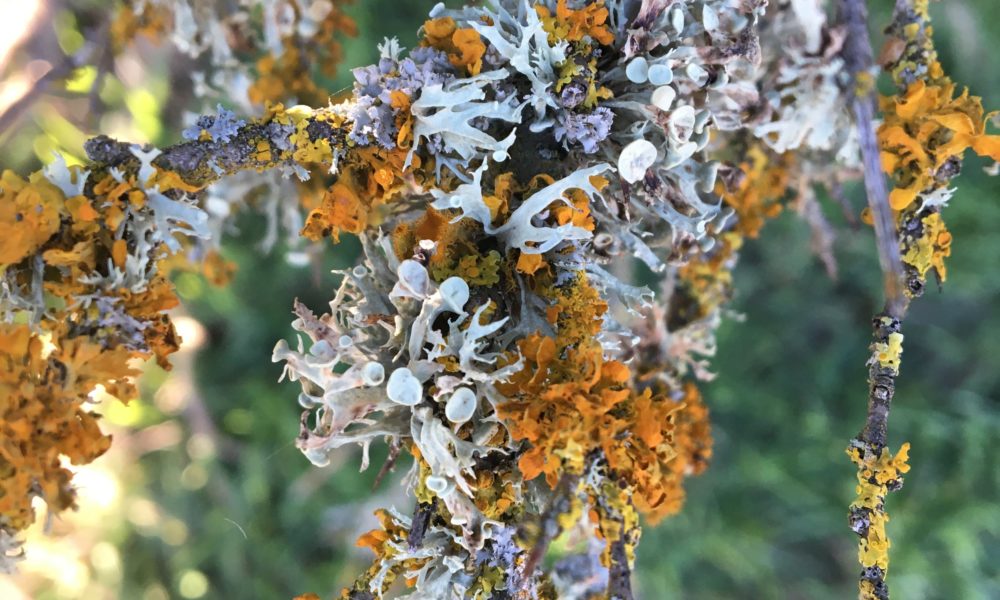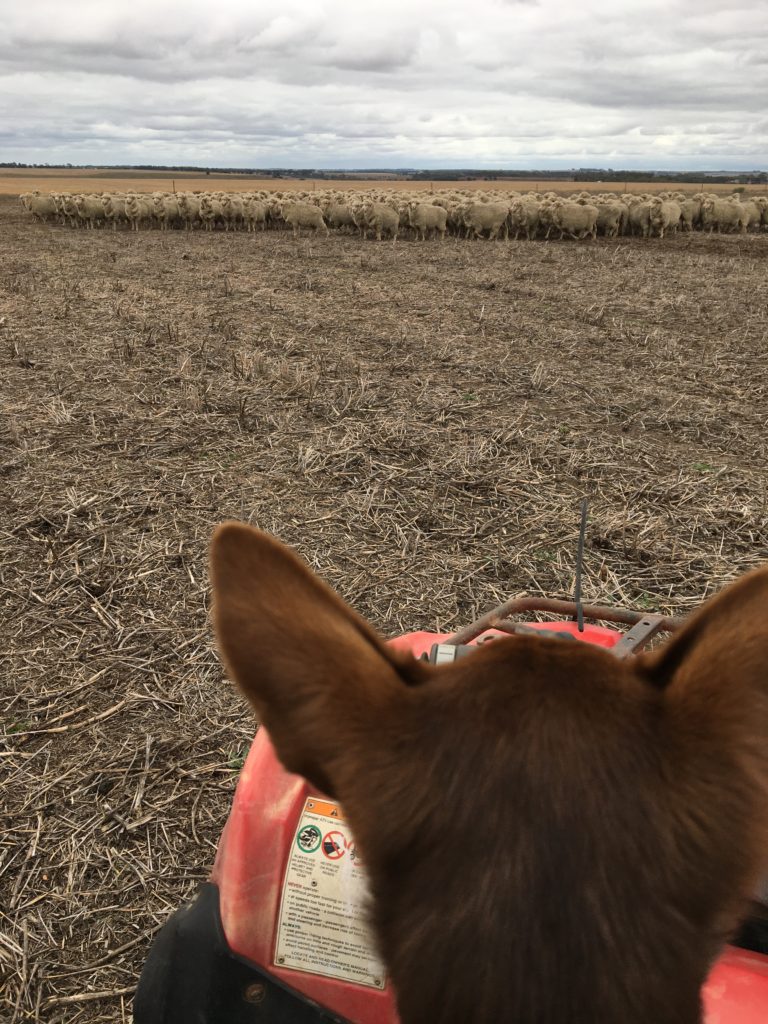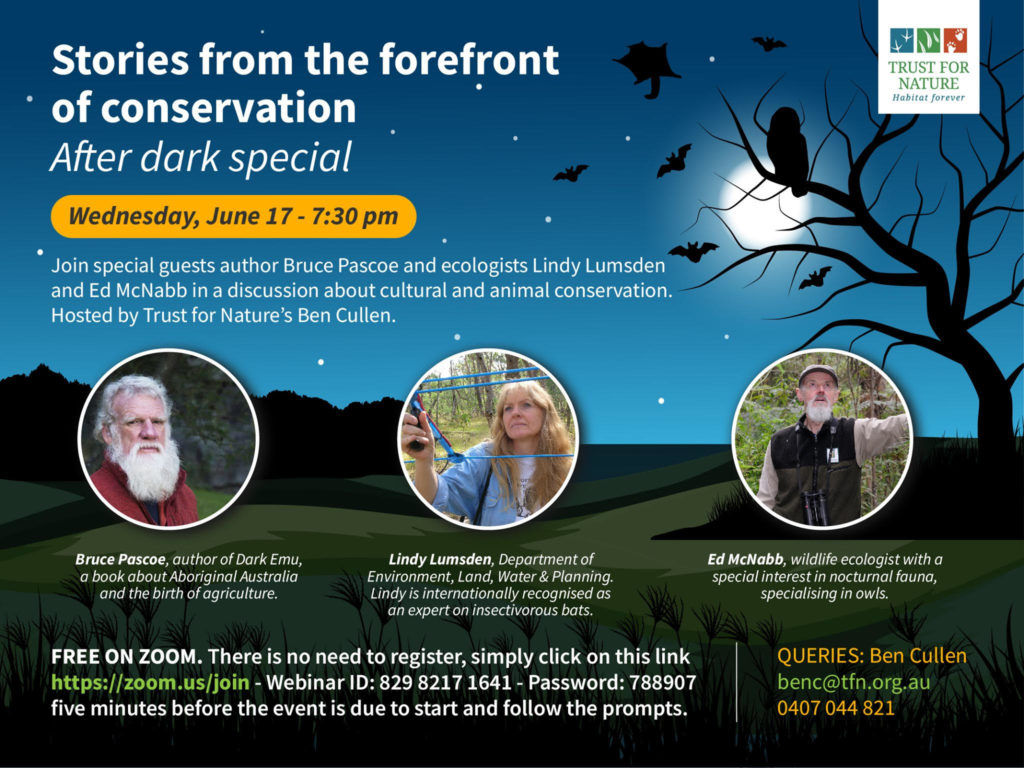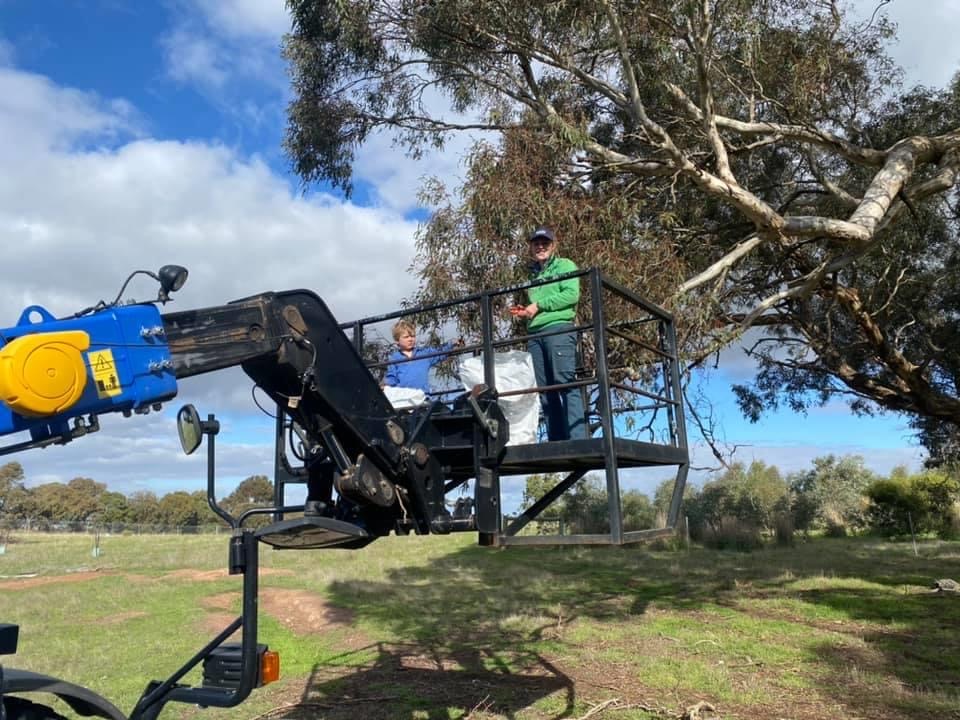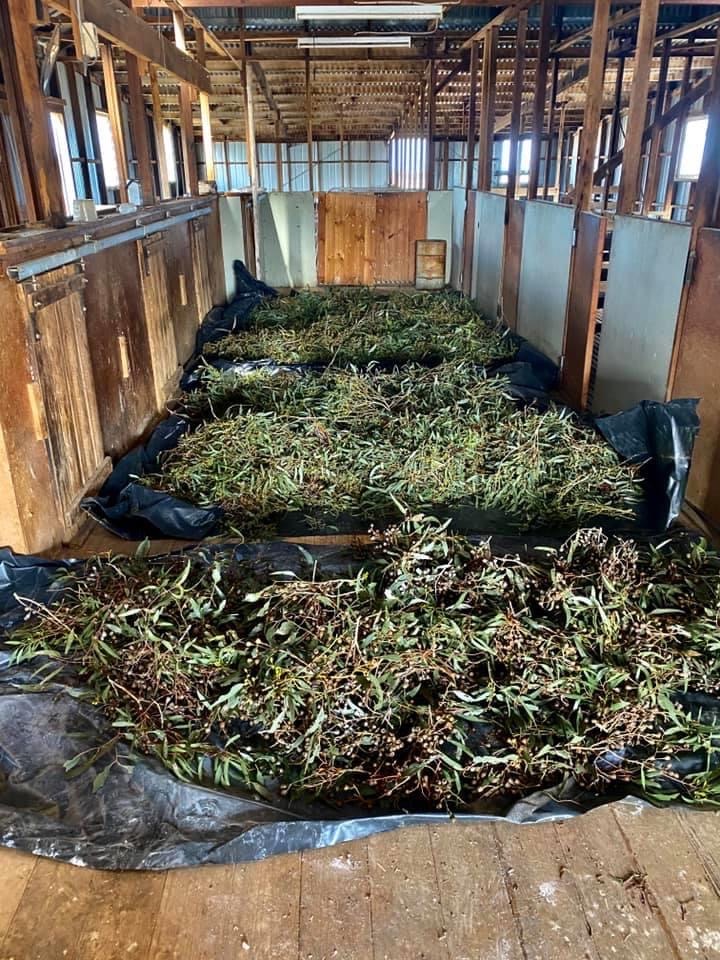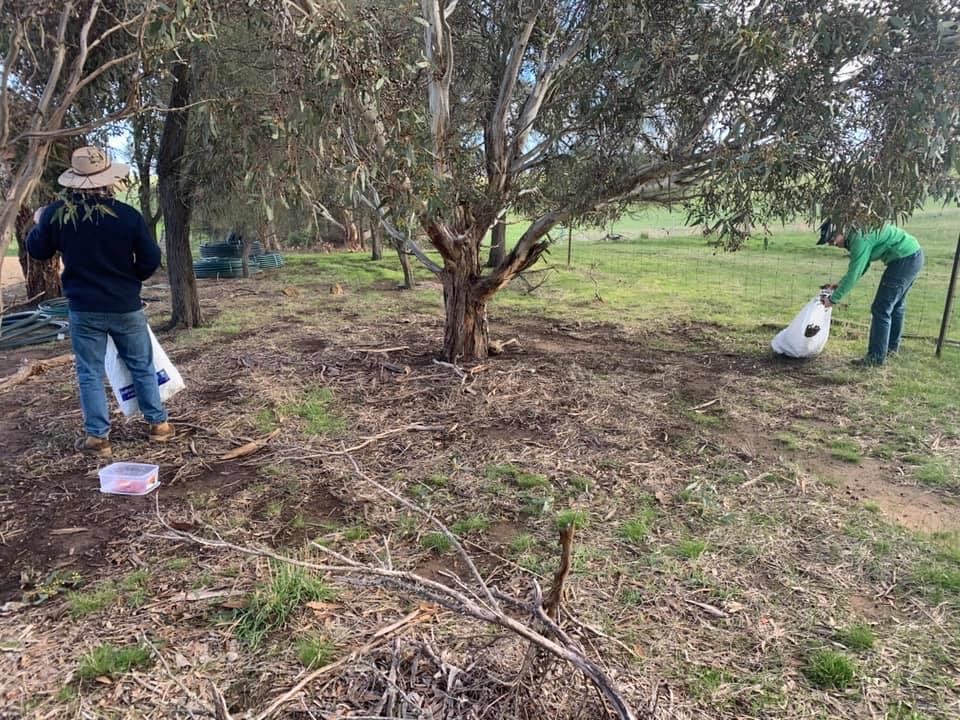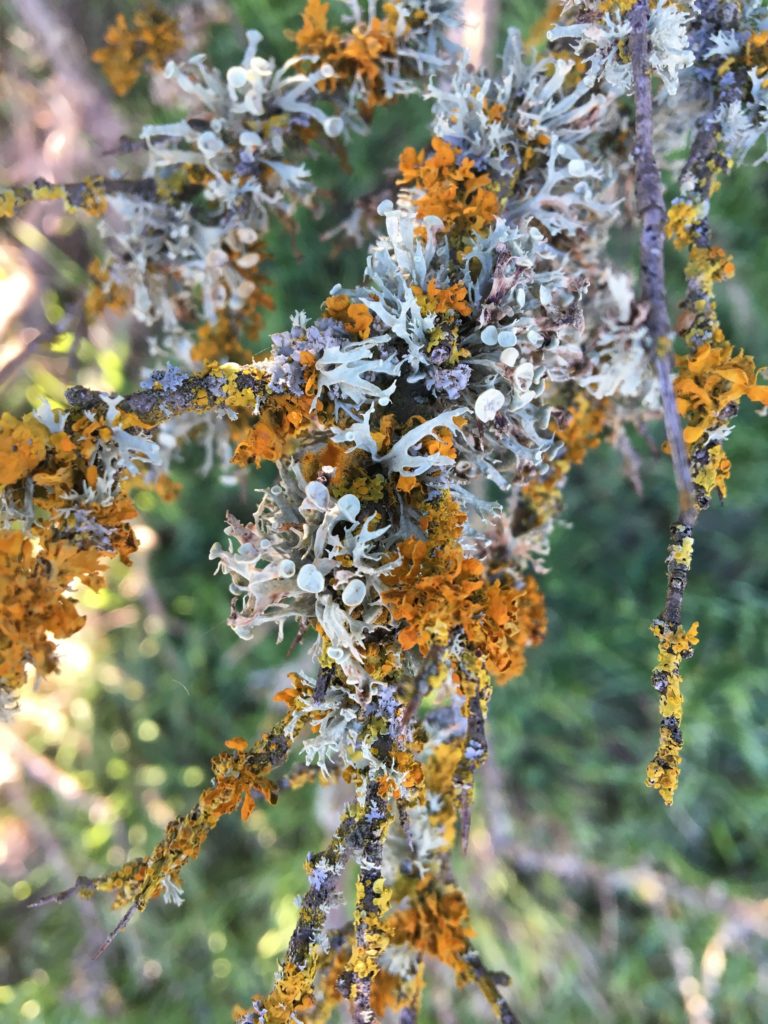
Landcare news and opportunities
Grants and funding
Young Farmers Scholarships are now open until 14 June 2020, providing young farmers in Victoria opportunities to access scholarships of up to $10,000 to help boost skills and implement new on-farm initiatives. It aims to support them in building productive and profitable careers in agriculture.
On-Farm Drought Resilience Grants are available to boost farmers’ access to professional services whilst still enabling farmers to invest in drought preparedness infrastructure.
Applications are now open Livestock Biosecurity Funds grants. Eligible projects and programs include those that prevent, monitor, and control diseases, enhancing animal health, biosecurity and market access for the benefit of Victorian cattle, sheep, goat, swine and honey bee industries.
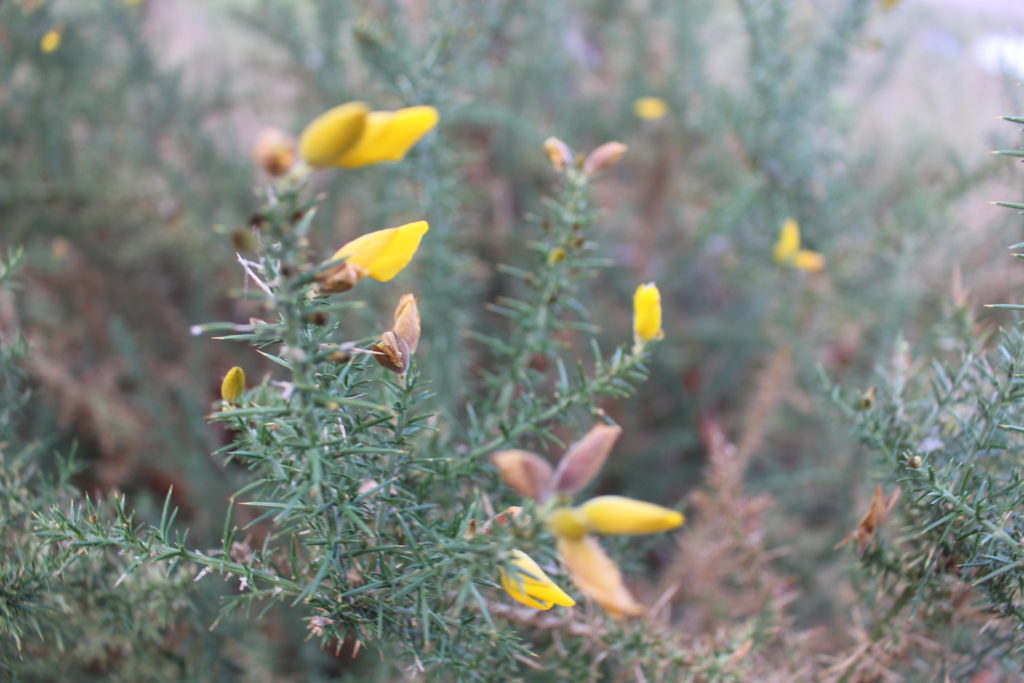
Information
Agricultural business FAQs for coronavirus have been developed to assist Victoria’s agricultural sector to ensure its important supply chains can continue to effectively produce and deliver food and other essential goods during the pandemic. They address a range of issues and have been developed in collaboration with the agriculture sector.
Victorian CMAs climate change priorities: Since 2012, Victoria’s 10 CMAs have been leading the way in planning for the impacts of climate change on the natural environment. They have collaborated to develop climate change strategies and plans, establish a set of statewide climate change priorities, undertake research projects and implement on-ground actions.
The Conservation Regulator and Parks Victoria have launched a statewide operation to address the destruction of wildlife habitat caused by illegal firewood collection in our forests, parks and reserves. Operation Hollows will help protect the environment and firewood supplies for community members through what is expected to be a difficult and challenging year ahead. To find out more about firewood collection rules, go to > www.ffm.vic.gov.au.”>www.ffm.vic.gov.au.
Agriculture Victoria has recently released a new factsheet about stubble burning and protecting paddock trees. Click on the download link below to see more.
Have your say
The Legislative Council Environment and Planning Committee has commenced an inquiry into ecosystem decline in Victoria that will look at measures to restore habitats and populations of threatened and endangered species. The Committee is inviting community input to the inquiry until 31 July 2020.
The Victorian Government remains committed to developing and implementing a Victorian Volunteer Strategy to support and enhance volunteering. Environmental volunteers are encouraged to share their thoughts and experiences before 31 December 2020.
Researchers from the University of Tasmania are working on a project to understand how farmers make decisions about planting trees on their farms. The end goal is to gain a better understanding of farmer preferences and priorities, which will ultimately help to improve extension efforts in farm restoration and agroforestry. You can contribute by filling out a 10 minute survey. If you have any questions about the survey, you can contact the researchers directly at zara.marais@utas.edu.au
Do you know a wetland? Wetland scientists have come together to gather and evaluate information from across the world and to lead a global assessment based on ‘citizen-science’ on the state of wetlands. You can complete a survey online for each of your local wetlands.
The Federal Government Department of Agriculture, Water and Environment has provided $4m in funding to the National Farmers Federation to develop the Australian Farm Biodiversity Certification Scheme Trial. NFF is now calling on farmers to provide their insights on how such a framework might work. It’s a chance to help reshape the interaction between agriculture and environmental regulation into the future. Go to the survey to have your opinion included.
Landholders are being invited to take part in a state-wide survey to better understand the social and behavioural factors that influence pest and weed management. The results will provide a better understanding of the barriers people face with implementing weed and rabbit control practices. Complete the survey at www.weedsandrabbits.com/survey/ before Sunday 24 June 2020.
Webinars and online resources
Webinars and online resources are frequently shared on the Upper Hopkins Land Management Group Facebook page. Follow us to stay up to date!
Landcare Victoria has created a diverse list of online training opportunities and recordings from previous webinars. You can find them all here: https://www.landcarevic.org.au/resources/victorian-landcare-training/.
Ongoing series
- Climate webinars from Agriculture Victoria
- Soils Network of Knowledge webinars from NSW DPI Agriculture
- Goulburn-Broken CMA Resilience Webinar Series
- AgTalk Podcast from the Centre for the Study of Agribusiness (CSA) at Marcus Oldham College
- Charlie Arnott’s The Regenerative Journey podcast (supported by Landcare Australia)
- Sustainable Farms podcast from the Australian National University
Catch up on webinars
- Whole farm planning presented by Clem Sturmfels, Agriculture Victoria
- Managing your pastures in a changing climate with Colin Seis
- Who needs to do what differently: why behavioural science matters in biodiversity conservation presented by Melissa Hatty, BehaviourWorks Australia
- Planning and designing a five star farm water supply – Agriculture Victoria
- Utter Opposites? Conservation in a Commercial Farming Context – International Land Conservation Network (ILCN)
- Soil Sampling – Why and How? presented by Kate Maddern, Birchip Cropping Group
- Soil carbon – What’s it all about? – Goulburn Broken CMA
Coming up soon
June 15 2020 Webinar celebrating Arthur Rylah Institute’s 50 years of ‘Science that Matters’ presented by Research Director Dr Kim Lowe. Kim will explore the past, present and future of ARI including history, policy, famous names and importantly, signposts of how environmental science has changed over the years since ARI’s beginning.
June 17 2020 Have you got a rabbit problem? Are your rabbit control efforts yet to be 100% successful? This ‘how-to’ interactive discussion hosted by Robert Hall of the Port Phillip & Westernport CMA and pest management expert Tim Bloomfield.

President’s report
by Jack Tucker, Upper Hopkins Land Management Group president
I hope you’ve all managed through this COVID period, it has certainly made for a memorable time in our lives. Aside from the lockdown period it is pleasing as Landcarers and farmers that we have had such a great start to the growing season.
We are very pleased to welcome several new members to our Group since the start of this year and each of them have some great plans and ideas for projects on their properties which we look forward to assisting them with.
Some of you may have been aware that funding for the Landcare Facilitators across the state ends at the end of June 2020 (this includes Ayesha’s position).
Fortunately, we received some welcome news on the 22nd May from the Minister for Energy, Environment and Climate Change, the Hon. Lily D’Ambrosio, announcing a 6-month extension (until 31 December 2020) of the existing Landcare facilitator positions funded through the Victorian Landcare Facilitator Program (VLFP).
The 6-month extension will enable the Department of Environment, Land, Water and Planning’s (DELWP) Victorian Landcare Program staff to run an Expression of Interest process later this year for Landcare and environmental volunteer groups and networks who would like to employ a VLFP-funded Landcare facilitator from 1 January 2021.
The extension will also allow for the implementation of improved processes for VLFP starting next year, as part of a suite of recommendations the Victorian Government is implementing following the 2019 independent Victorian Landcare Facilitator Program Review.
Right now is a great time to spray any gorse that you might have on your property as it is flowering and therefore easy to identify. Don’t forget that we have a spray unit available for members to use and we have some 50:50 funding to assist with the cost of herbicide and/or contract labour relating to gorse control on private property. If you notice any bad patches of gorse on roadsides please report it to the Council.
We are aware that rabbits are an ongoing issue across our region and appear to be increasing in numbers in some areas. If they are of particular concern to you please let us know so we have an idea of problem areas. That way if a funding opportunity presents itself to our Group we can take a more targeted approach.
Finally, a lot of the local indigenous trees and shrubs have had a prolific seeding season and I (as I’m sure many others) have been out recently collecting Red Gum and Yellow Box ready for direct seeding projects we have planned for later in the year. Other species such as Melaleuca’s, Callistemon’s and Allocasuarina verticillata can be collected throughout the year.
As always please don’t hesitate to be in touch with Ayesha if you have any Landcare projects in mind that you think we may be able to support you with, whether it is funding or advice. Remember no project is too big or too small, it is all worth enquiring about.
Happy Landcaring!
Jack Tucker
Natural regeneration opportunities in wet years
by Peter Forster
The easiest way to grow trees is to allow natural regeneration from remnant trees when conditions are suitable. The summer of 2010/11 was such a year. Very heavy tropical rains allowed prolific regeneration of red gums where ground and grazing conditions allowed the seedlings to get away.
The oat stubble in the lower paddock at the Bullock Hills sprouted red gums with seed coming from a few very old trees. A section was selected for fencing for stock exclusion. The resulting stand is a mix of what will be habitat trees when they age and very closely spaced taller trees.
Some advantages of natural regeneration are low cost of establishment, local provenance and fast growth rates. There are several examples of natural regeneration surviving on our neighbours’ properties as you can see in the photo. After continual sheep grazing for 170 years many district paddocks now have just a few lonely surviving paddock trees. There are limited opportunities to preserve their genetic material which has resulted from natural selection over thousands of years.
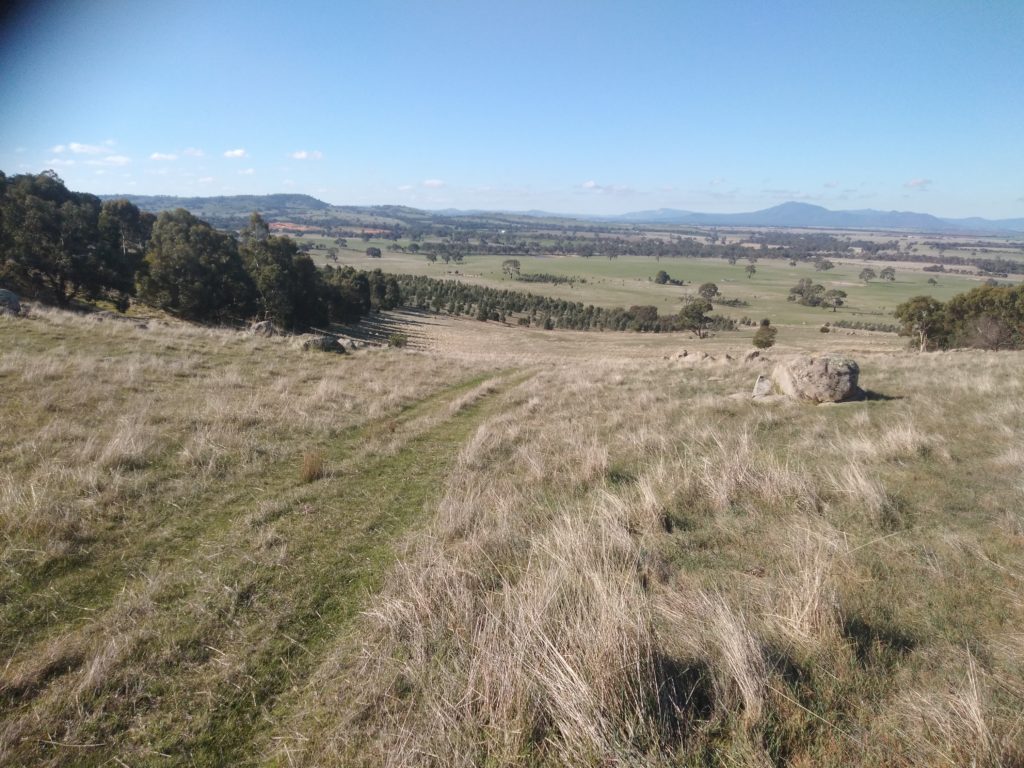
The view from the top of Bullock Hills 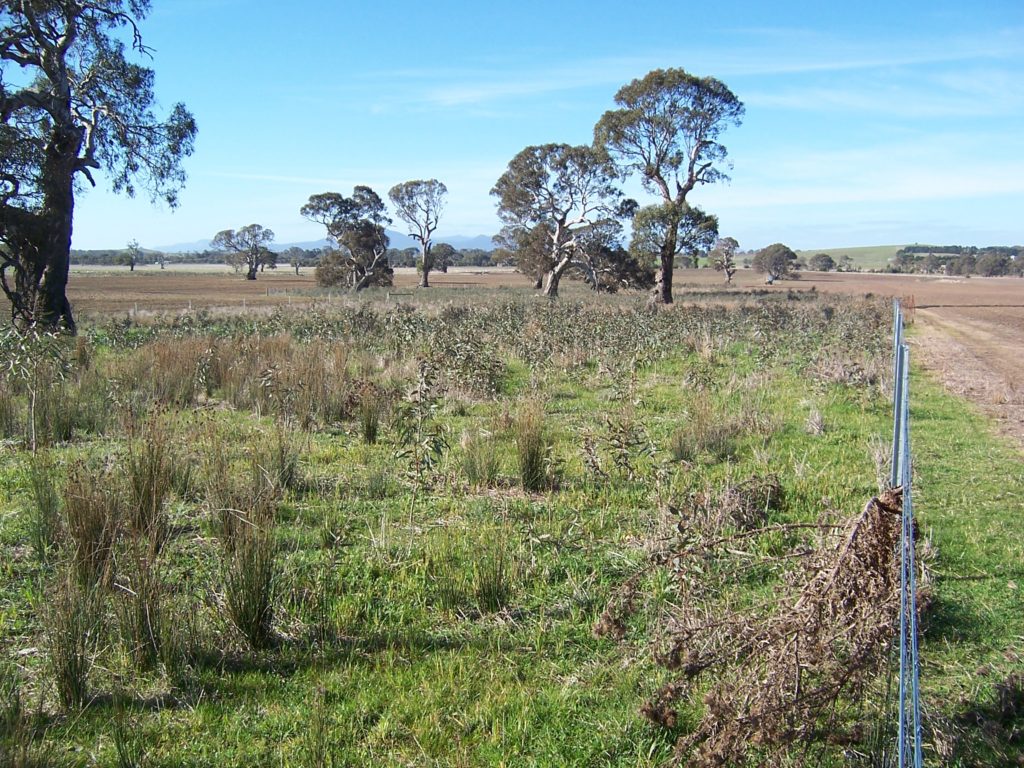
Natural red gum regeneration.
Photos: supplied by Peter Forster
Cropping swamps and wetlands… it’s not worth the cost
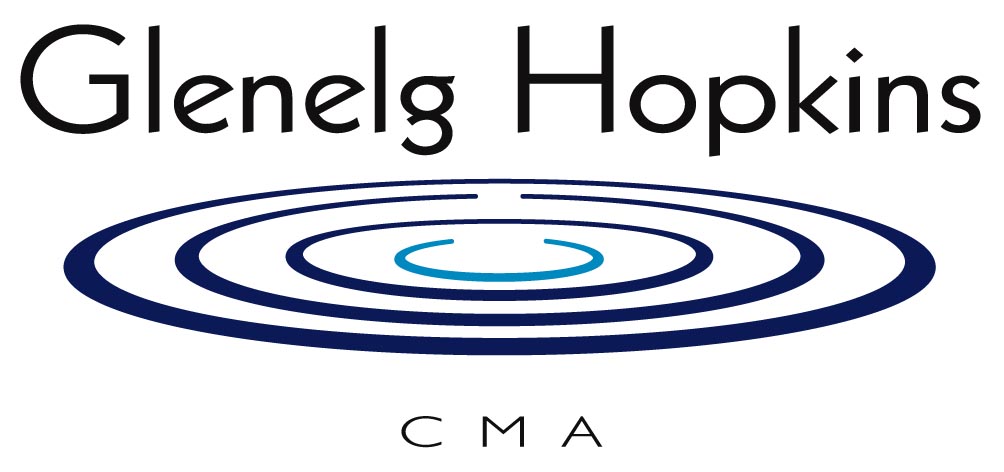
With farmers preparing to start their winter cropping program, Glenelg Hopkins CMA is reminding landholders that it could cost more than they think if they sow into swamp and wetland areas.
At this time of year, many swamps, wetlands and boggy paddocks are now dry, making it tempting to sow crops into these areas, but they are urged to simply plant around them.
The cost of sowing into these areas could be far greater than the yield lost once they turn wet again.
Glenelg Hopkins CMA Senior Field Services Officer, Tania Parker, said traditionally ‘boggy areas’ of paddocks are often wetlands that naturally wet and dry as seasonal conditions change.
“These areas are important to the region as naturally occurring swamps and wetlands, and even though they might be dry now, they will get wet again”, Tania said.
Sowing crop or pasture in them in dry years can not only damage these wetlands, but significant fines can be issued for damaging these protected areas.
Swamps and wetlands, whether wet or dry, are protected under State and Federal Government laws and farmers could face significant fines if these areas are drained or destroyed. “The last thing we want is farmers getting into trouble by damaging our region’s wetlands and swamps,” Tania said.
Swamps have immense diversity and provide homes to a range of insects, frogs and native birds, including the iconic Brolga, which can be beneficial to the entire farming operation.

Farmers are urged to simply plant crops around wetland areas like in the paddock pictured to avoid yield losses and potential penalties for damaging wetlands.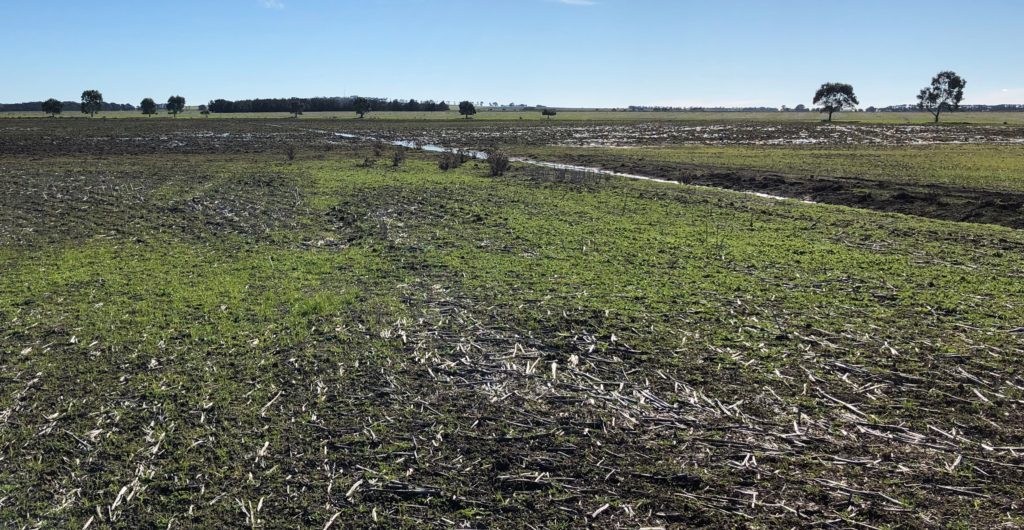
Example of what NOT to do – a drained swamp and failed waterlogged crop.
“The high clay content in soils in these areas isn’t productive for growing high yielding crops, so we are helping landholders to crop around these areas, not through them,” Tania said.
Apart from the high financial inputs required, swamps and wetlands are protected and many can be managed by stock grazing when dry, but allowed to flourish in the winter months when they have water in them
“Grazing is feasible within a fenced swamp or wetland area – we are just urging farmers not to crop them.”
There are more than 5,400 wetlands covering 73,000 ha or three percent of the Glenelg Hopkins region. This is 14 percent of Victoria’s total wetland area and 44 percent of the State’s total number of wetlands.
Glenelg Hopkins CMA can assist landholders with decision making and funding options to crop around wet areas and manage them as part of the farm business. There is also the opportunity for farmers to investigate funding options through other nationally funded programs.
The Hopkins Wetlands project is part of the Victorian Government’s $222 million investment to improve the health of waterways and catchments and will be completed in December 2020.
For additional information, contact Glenelg Hopkins CMA on (03) 5571 2526.
Upper Hopkins Land Management Group membership renewal
by Celia Tucker, Upper Hopkins Land Management Group secretary
Our membership year runs from 1st July until 30th June and our members have the option to pay for a 1 year or 3 year period ($27.50 or $66.00 incl. GST) . On the 1st July, 2020 those whose membership is due for renewal will receive an email from us. Be sure to check for this email when the time comes as it will include instructions on how to renew your membership. As Ayesha Burdett (our Group Facilitator) mentioned in the last newsletter, we have been working with Tom Parkes to move our membership renewal process to an online system via our new look website: www.UpperHopkins.org.au.
We understand that some of our members may not wish to pay online so the reminder email you receive will also provide details on how to pay via direct debit or cheque. Our preference is that people pay online with a credit card as this makes for less administration but we also understand that this doesn’t suit everyone.
If you aren’t currently a member of our Group but are interested in becoming one or simply want to learn more about what we do you can visit our website or you can also follow us on Facebook, Twitter and Instagram.
As a financial member, Ayesha will inform you of any grant opportunities and can work with landholders to submit proposals to various funding agencies. Please contact Ayesha directly if you have ideas for a project.
Not only does a financial membership give you access to funding opportunities but it also entitles you to borrow equipment from the group which includes:
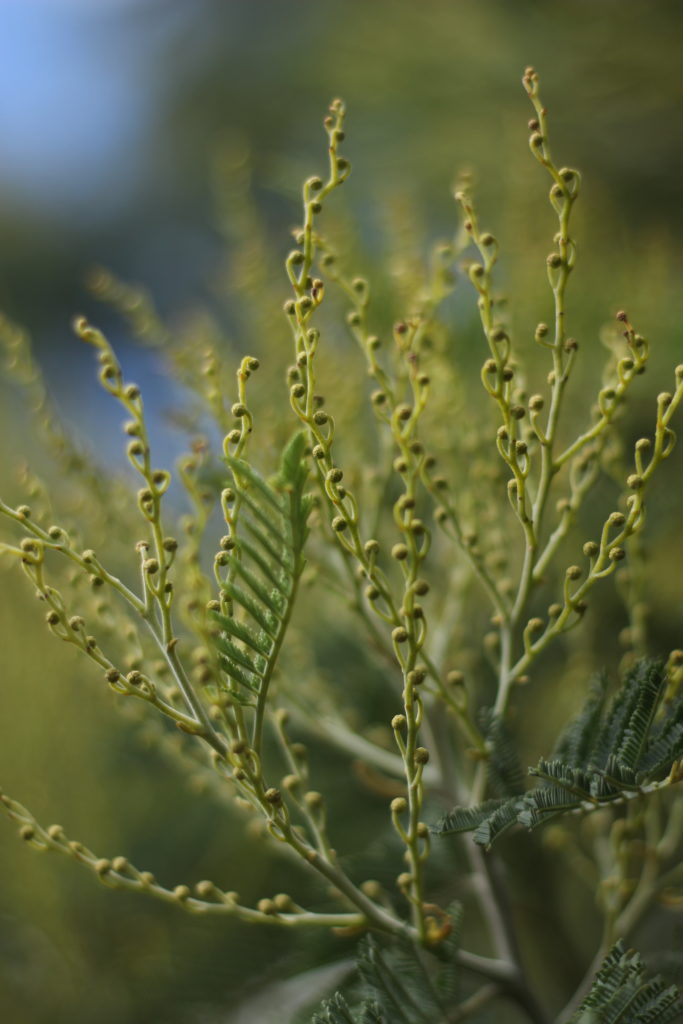
- a towable boom spray which is available for paid members to use for control of environmental weeds such as gorse and briar rose, on your property;
- a spray unit which can be mounted on an ATV or ute with a hand held sprayer;
- two direct seeders which may be of use for re-vegetation projects;
- four Hamilton tree planters (two Hiko cell and two forestry tube size); and
- four remote sensing cameras for monitoring native wildlife and pest animals.
The Upper Hopkins Land Management Group offers an Integrated Pest Management (IPM) program to agronomists and farmers in the Upper Hopkins region. This project is supported by the Glenelg Hopkins Catchment Management Authority (CMA) through funding from the Australian Government’s Regional Landcare Facilitator Project.
The Upper Hopkins newsletter is distributed quarterly and aims to keep members and the broader community informed of Landcare related matters from around the region and further afield. If you have an article, photo or anything else that you think may be of interest we always welcome contributions.
If you have any queries about renewing your membership or becoming a financial member of our Group please don’t hesitate to contact myself or Ayesha anytime. We are here to help you and it is really encouraging to see the number of Landcare projects that continue to be undertaken across our region with or without funding!
Cheers,
Celia Tucker
Secretary
Congratulations to Celia Tucker
The Secretary of the Upper Hopkins Land Management Group has recently been welcomed to the Landcare Victoria Inc. Committee of Management. Celia will represent the needs and interests of our group at the State level.
The LVI Committee of Management for 2020 is Acting Chair Terry Hubbard (Goulburn Broken), Treasurer Leanne Jackman (Wimmera), Secretary Beth Ripper (West Gippsland), Alice Knight (Corangamite), Jenny Robertson (East Gippsland), Celia Tucker (Glenelg Hopkins), Ian Arney (Mallee), Paul Foreman (North Central) Jane Carney (North East), Marijke de Bever-Price (Port Phillip and Westernport) and Professional Landcarers Kerri Robson and Scott Elliot. For more information on each LVI Committee of Management member click here.
Many thanks to Celia for continuing to contribute to Landcare in the Upper Hopkins in so many ways.

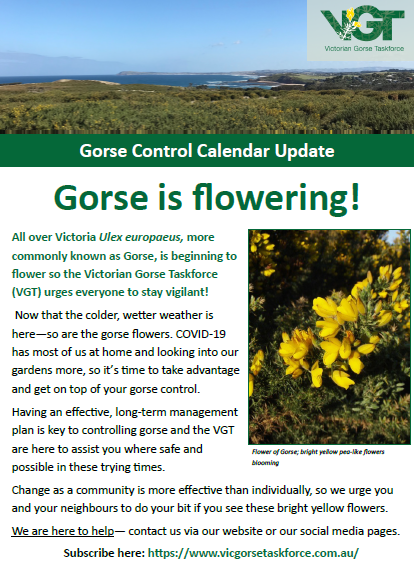
Girls & Grass Advisory Group

by Debbie Shea, Girls and Grass Facilitator
The Perennial Pasture Systems (PPS) group recognises the importance of farmer health and well being in enabling farmers to make cohesive and informed management decisions. These decisions are often made jointly with partners and/or parents and/or siblings. This understanding has led PPS to be more inclusive to all members of the farm business and has resulted in the formation ofGirls & Grass.
PPS recognises and celebrates the essential contribution that rural women make to not just their own farms but the wider rural community. Girls & Grass AG (Advisory Group), with support from Rural Bank, provides opportunities for members to come together in a friendly and supportive environment to learn from their peers and build on their skills and knowledge.
Girls & Grass works closely with the PPS Committee of Management to value add to the existing calendar of events, as well as conducting their own activities. The venues for events are scattered throughout the region from Elmhurst to Pomonal and from Lake Bolac to Stawell. The COVID-19 restrictions have meant a postponement of open events the last one being a coffee morning at the Willaura Bakery in March. The ‘Conversation over Coffee’ social gatherings are a way of keeping in touch.
The Girls & Grass AG works closely with other organisations to benefit our rural community. When high profile speaker Sue Pieters-Hawke was engaged to speak last year, Girls & Grass formed a steering committee with Grampians Pyrenees Primary Care Partnership, Ararat Rural City Council, East Grampians Health Service, Northern Grampians and Grampians Community Health to maximise the opportunity. This resulted in Sue speaking at the Girls & Grass dinner held in Great Western, an afternoon tea at Pyrenees House and a morning tea at the Lake Bolac Bush Nursing Centre. In all over 150 people heard from Sue and her experience with caring for her mother Hazel suffering from Alzhiemers.
Planning is well underway for the regular ‘Xmas in July’ Dinner, especially seeing the restrictions are slowly lifting, hopefully by July we will be able to enjoy getting together.
For membership or information contact Girls & Grass Facilitator; Debbie Shea: mobile 0418 205 353, email debbiejshea@gmail.com.
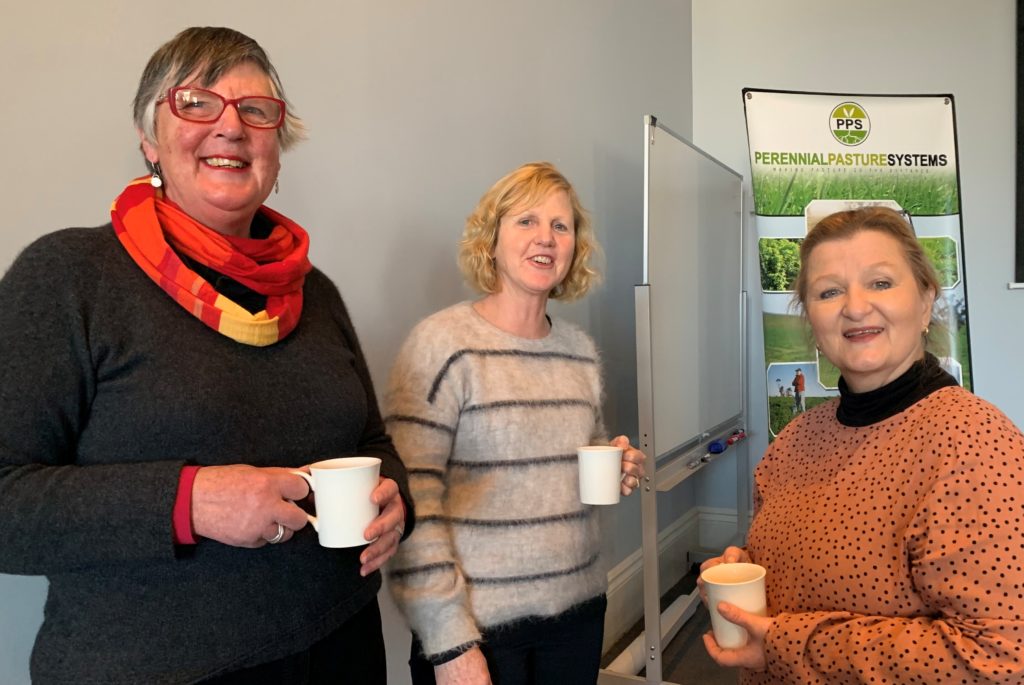
Girls & Grass AG members Jane Thomas and Sue Maconachie chat with Sue Pieters- Hawke. 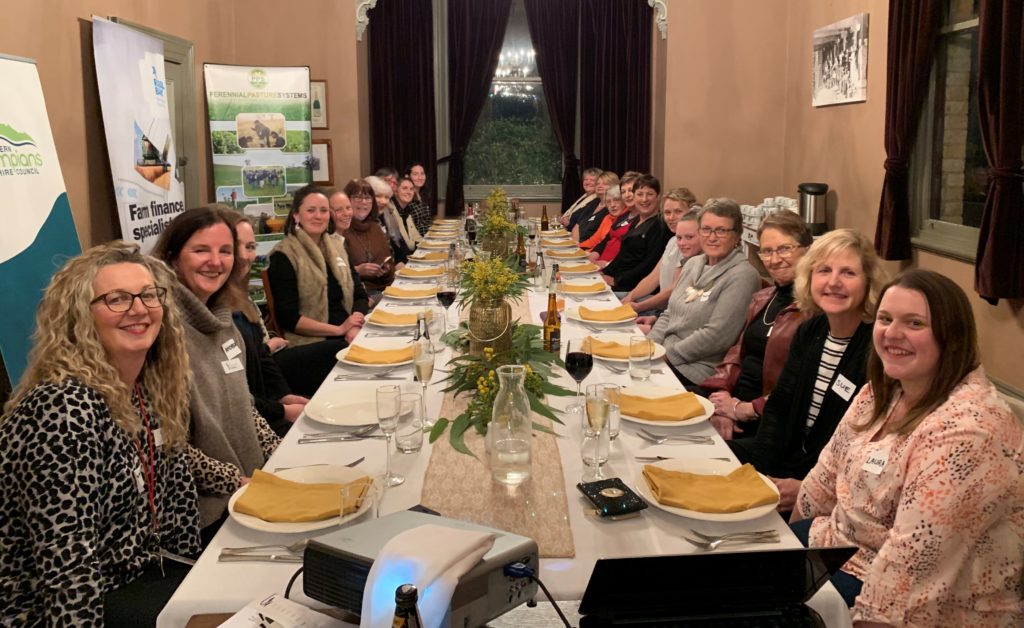
2019 ‘Xmas in July’ Dinner held in the Seppelt Homestead.
Governance training and capacity building
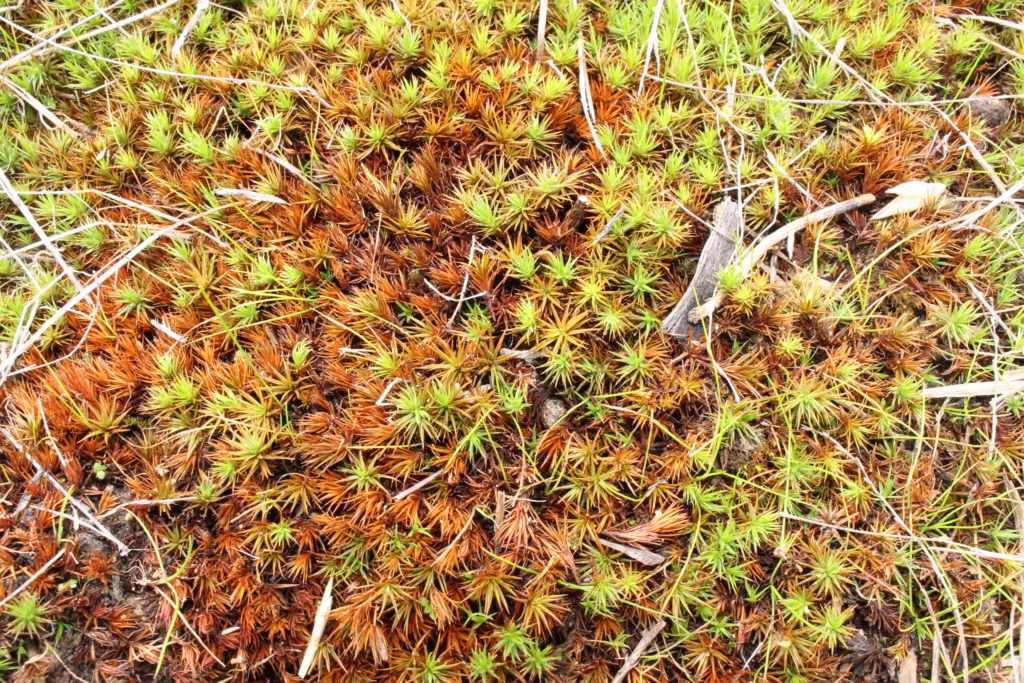
Are you interested in joining a committee but are not sure where to start? The Upper Hopkins Land Management Group has received funding from the Glenelg Hopkins CMA to support a capacity building project. We’re planning to host a training session later in winter to learn about good governance and how you can be a valuable committee member in our community.
While we’re still planning to details of the workshop, we would love to hear from you about your experience and what you would like to learn. Please take five minutes to complete this survey to let us know!
Southern Farming Systems delivering extension in the Glenelg Hopkins Community
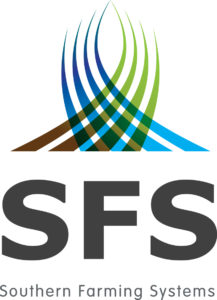
By Michelle McClure, SFS Hamilton, Streatham and Geelong Branch Coordinator
Southern Farming Systems is delivering information to the Glenelg Hopkins Catchment area on Sodic Soils through community events and Women on Farms program with support from Glenelg Hopkins Catchment Management Authority through funding from the Australian Government’s National Landcare Program.
Community Events
SFS hosted a Sodic Soils webinar on the 17th April 2020 with Cam Nicholson. This webinar was part of the GHCMA Soils Program and is available on the SFS You Tube Channel.
SFS delivers 3 community events every year with groups in the region on the topics of soils, pastures, climate and crops. Expressions of interest will be advertised to groups through the landcare newsletter later in the year.
Women on Farms
SFS has established two Women on Farms groups in Lake Bolac and Hamilton regions since 2017.
We have run 8 sessions in each location covering the topics:
- Climate & Soils
- Pasture Production
- Crop Production
- Livestock Production
And 4 advanced sessions on Integrated Weed Management.
The last 2 sessions on IWM were forced to go online due to COVD-19 restrictions allowing more than the local groups to further their knowledge on the topics of IWM. The recordings from these last 2 sessions are available on the SFS You Tube Channel (click for IWM Session 3 or IWM Session 4).
The next round of Women on Farms Sessions will be announced after 30 June 2020. The current members of the Women on Farms Groups have been asked to select the topic they would like delivered.
To join the group you can contact Michelle McClure mmclure@sfs.org.au or join their Facebook page Glenelg Hopkins Rural Women.
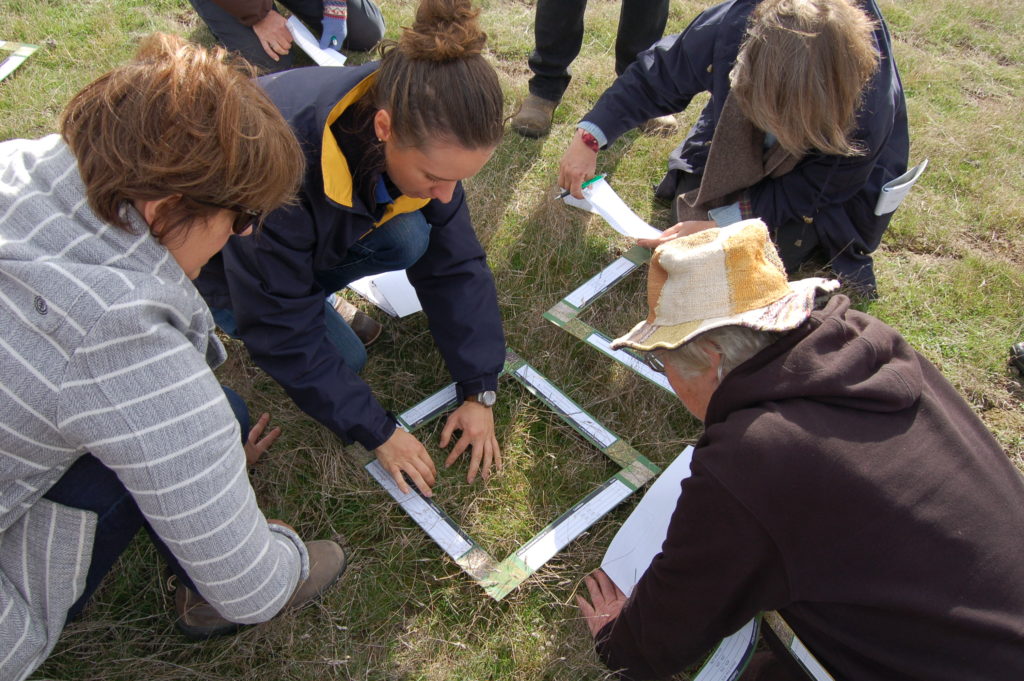
Women on Farm Session Two – Lake Bolac Group learning how to assess Pastures using Pasture Paramedic.
Soil CRC national conference
by Ayesha Burdett, Upper Hopkins Land Management Group
As a member of the Soil CRC Community of Practice, I was invited to attend the annual Soil CRC Participants Conference. We were scheduled to get together in Adelaide in late March, but the coronavirus had other plans and the meeting was quickly shifted to an online platform.
Each of the leaders from the four programs presented on the purpose and progress of their work.
Program 1 – Investing in high performance soils
Associate Professor Catherine Allan – Charles Sturt University
This program is focused on the “human stuff” that influences decision-making to support farmers to maintain the integrity and fertility of soils. In her presentation, she discussed the challenges of balancing economic decisions with long-term investments in the soil.
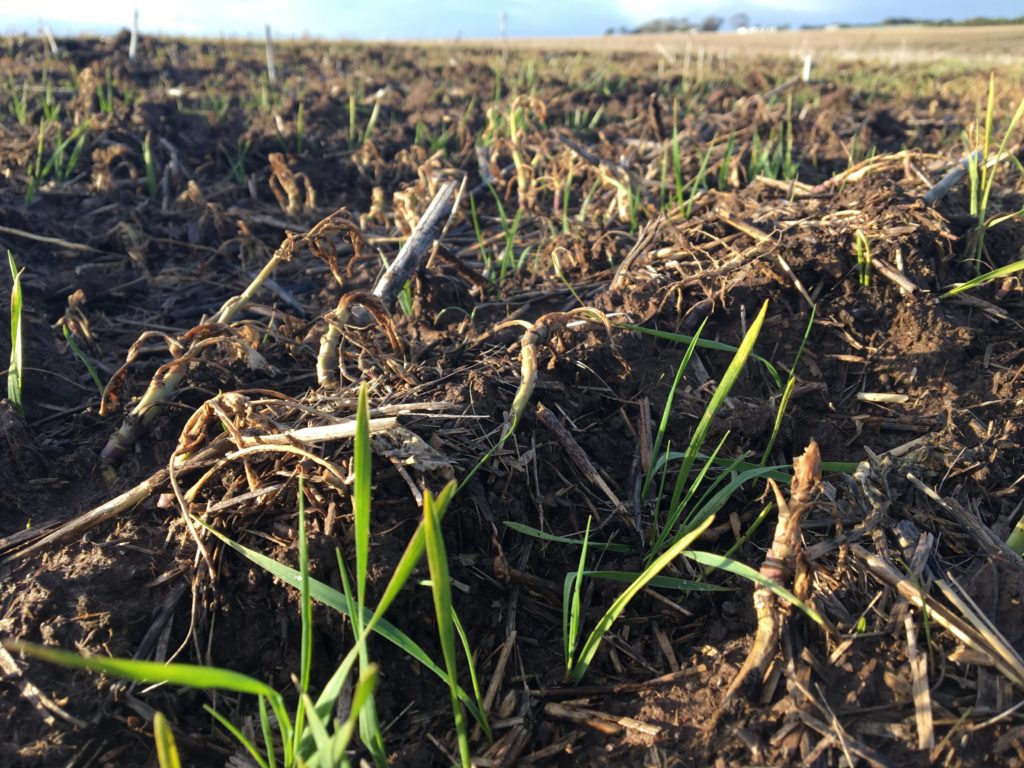
Program 2 – Soil performance metrics
Associate Professor Richard Doyle – University of Tasmania
This program takes an engineering and technological approach to managing soil health. Researchers are developing several innovative and exciting products to measure soil performance accurately and quickly such as the ‘smart shovel’ to measure soil moisture and salinity throughout the paddock.
Program 3 – New products to increase fertility and production
Professor Nanthi Bolan – The University of Newcastle
Under this program, researchers are investigating new types of soil amendments and new delivery mechanisms. For example, they are looking at high-performance fertilisers and other novel materials to address soil constraints such as soil acidity. Broadly, two types of delivery systems are being investigated: some for pesticides that will improve pesticide use efficiency and reduce off-site contamination, and others for beneficial microorganisms to promote soil health and productivity
Program 4 – Integrated and precision soil management solutions
Dr Lukas Van Zwieten – Department of Primary Industries, NSW
The goal of this program is to bring together current understanding of soil science to produce a range of tools that can be applied to the key soil types across Australia. This group is working on reducing the yield gap caused by a number of soil constraints, and are conducting several large-scale trials to experiment with different management techniques.
It was exciting to hear about the diverse range of research being conducted for the Soil CRC, and to imagine some of the long-term outcomes for soil health on our farms. If you want to learn more about the Soil CRC, go to https://soilcrc.com.au/.
Recycling grain bags

By Stuart Horner, Grampians Central West Waste and Resource Recovery Group
The Grampians Central West Waste and Resource Recovery Group (GCWWRRG) has been working with the Victorian Farmers Federation (VFF), farm suppliers, local government and Sustainability Victoria (SV) to develop a process for collection and reprocessing flexible agricultural plastics. As things currently stand, there is no effective mechanism for the collection and re-use of these products. Some small scale and piecemeal recycling arrangements exist, but the longevity and stability of these arrangements cannot be assured. GCWWRRG is looking to develop a more robust, broader scale and nationally uniform approach to this problem, based on the Drum Muster and the Canadian grain bag product stewardship precedents already in existence.
A Statewide agricultural plastics working group is being established, involving Waste and Resource Recovery Groups, the VFF and several shire councils. An Initial meeting between SV, the VFF and GCWWRRG has established common ground around the need to develop a collection and recycling system. The VFF indicated that there was unanimous support by VFF members at the recent grains conference to take action on ag plastics, with a view to spreading the cost of retrieval and processing across the entire supply chain, including manufacturers, suppliers and farmers. The working group is in the process of sourcing the details of manufacturers and suppliers into a database to inform the next steps of the process.
To raise awareness, GCWWRRG has also instigated a competition for the best use of agricultural plastic in the creation of a fashion item or accessory. The intent of this exercise is to raise awareness of the problem of agricultural plastic waste, and to draw upon the skills of the local fashion industry and general public to develop a potential avenue of ongoing scalable and commercially viable re-use of agricultural plastics. Secondary benefits may include raising overall awareness of waste in the fashion industry and the prompting of innovative solutions to other waste problems from both the fashion and allied industries. The website is live at ballaratethicalfashion.com.au/voguegonerogue.
GCWWRRG is a Statutory Authority established under Section 49C of the Victorian Environment Protection Act (1970). Our Mission is ‘To reduce waste and maximise recycling and resource recovery through information sharing, project development and collaborating with local government and industry.’
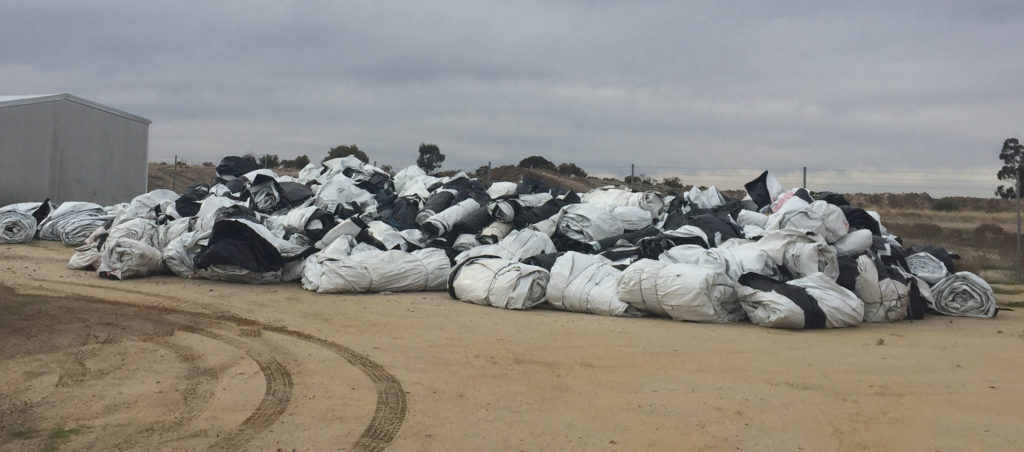
Waste grain bags – how can we recycle them? 
Maroona Windfarm Fund benefits local projects
The Maroona Wind Farm Community Fund, an annual payment from the Maroona Wind Farm, ensures that the entire Maroona community benefits from the wind farm.
This year, the Maroona Wind Farm Selection Panel has awarded funding to three local groups for projects that support the community.
- The Maroona Recreation Reserve Committee received funding to create commemorative biscuit tins that celebrate the Maroona Avenue of Honour. A limited edition of tins will be produced to be sold locally. Any profits from the sale of the tins will benefit the Recreation Reserve.
- Friends of Lake Buninjon received funding to construct picnic tables at Lake Buninjon as part of a bigger plan to improve access and amenities at the Lake.
- The Maroona Primary School received support to construct a 20,000 litre water tank to connect to the East Grampians Rural Pipeline. This tank will have dual benefits of improving the gardens and grounds of the school and helping to make the school bushfire-ready.
Previous projects supported by the MWF Community Fund include improving the track into Lake Buninjon, replacing carpet at the Maroona Recreation Reserve and constructing bat boxes to benefit natural wildlife in the area.
The next round of funding from the Windfarm will be available early in 2021 and community groups within a 10 km radius of Maroona will be invited to apply.
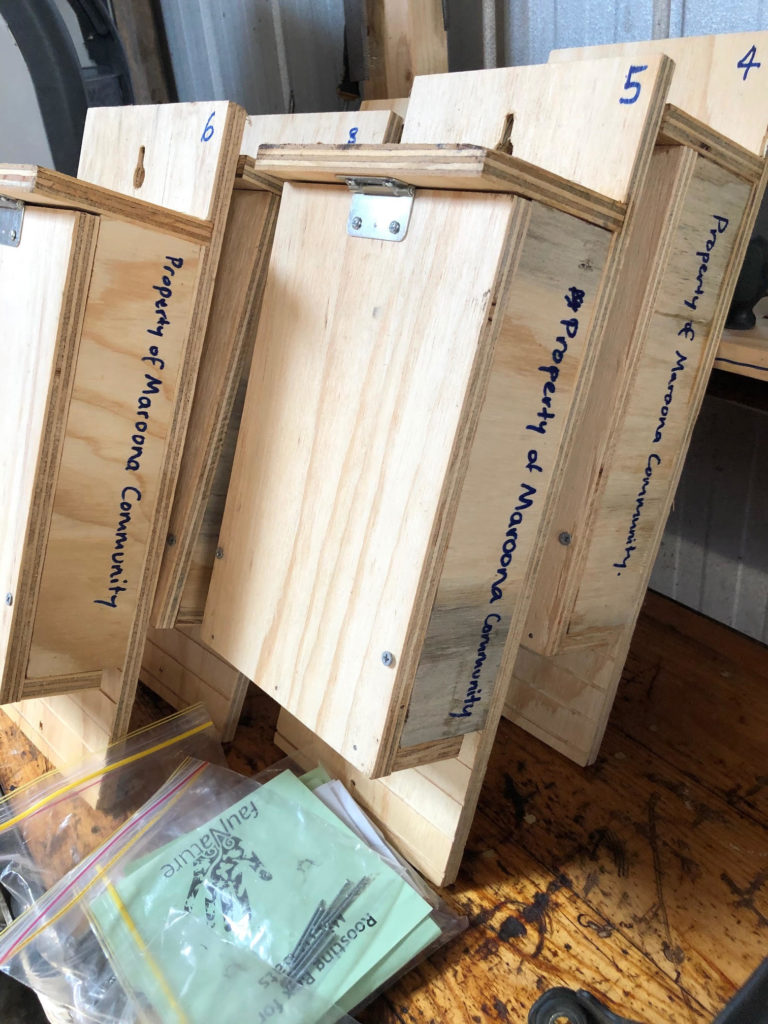
Bat boxes constructed with Maroona Windfarm Community funding. 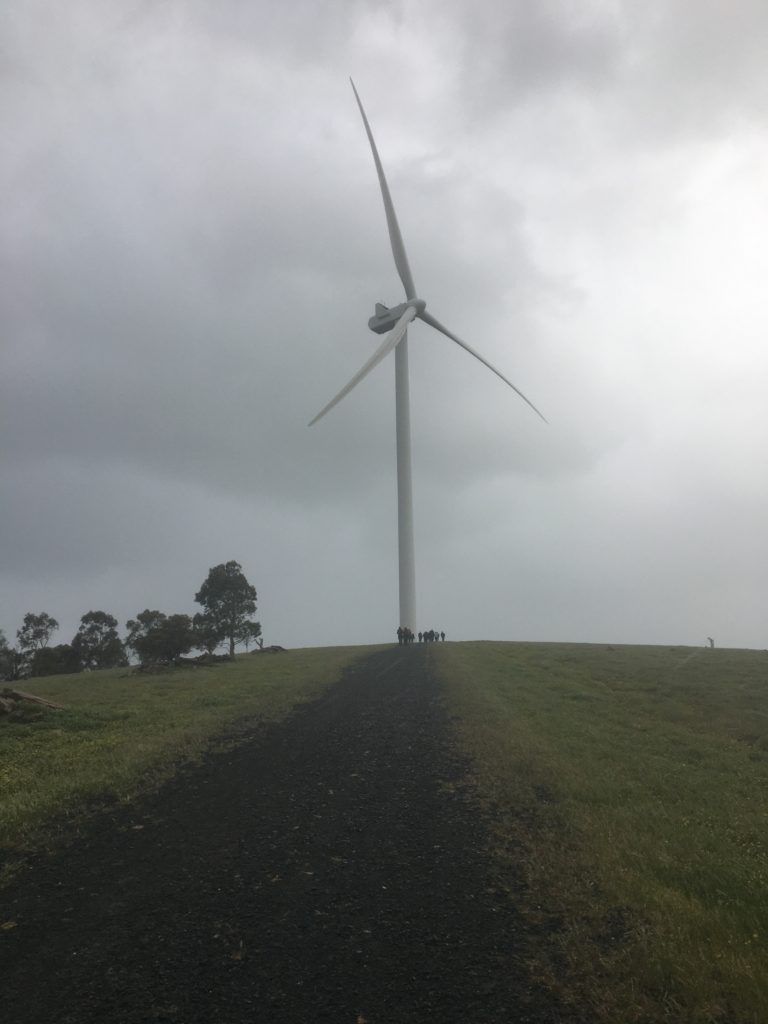
Landcare members visited the Maroona Windfarm during the 2019 end-of-year gathering.
An update on the Grampians Region Climate Adaptation Strategy
By Daryl Scherger, Grampians Region Climate Adaptation Group
The strategy is starting to come together with the Regional Climate Adaptation Group (RCAG) developing a preliminary draft. Two biodiversity projects being considered for this year are :
- A project is to develop a rationale, a species selection and a practices guide for the purpose of maintaining and enhancing headwater stream biota health and biodiversity within peri urban landscapes.
- A landscape genomic analyses of Grampians Region biodiversity to develop a management framework for preserving patterns of endemism and maximising environmental resilience under climate change.
More projects are needed for subsequent years of the strategy and I’d recommend the Upper Hopkins Group to put forward their projects for consideration. The amount of funding available has yet to announced but the Victorian Government has committed to long term support of the strategy.
A website for the strategy program is being developed and will be launched soon. Anyone wanting more information can visit https://engage.vic.gov.au/grampians-region-climate-adaptation-strategy or call 136 186
News from the Beyond Bolac Catchment Action Group
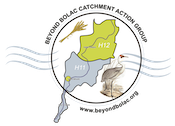
by Anthony Casanova, Facilitator for the Beyond Bolac Catchment Action Group
The Beyond Bolac website has been recently updated, and you are invited to click on the link below and to have a look around. The website now includes a wide range of information and links on the natural attributes of this district, especially via the menu tabs along the top of each page. The process of pulling these various topics together was an experience that highlighted the fact that we do live in a unique part of the world.
Initially the focus of the added information was based around the themes of runoff across the catchment and its influence on the health of Lake Bolac. This was the issue that led to the formation of the Beyond Bolac group. Recently there has been renewed interest in revisiting these issues, and we are in the fortunate position that over the decade since BBCAG began there has been a large amount of new knowledge gained on this topic. The major aspects can now be accessed from the site. The website also pulls together an overview of the wetlands and biodiversity of our region.
There were a few objectives that lie behind developing the website. Firstly it is a vehicle for publicity for BBCAG, but that on its own would be of limited value. Secondly, the themes and issues on the site will be useful for giving an overview to people such as researchers or decision makers who may be coming from outside to work on a particular aspect of our catchment. For them to be able to see their field in the wider catchment context can help with setting priorities or to raise new questions that might otherwise have been overlooked. Finally, and perhaps most importantly, we hope that the site will act as an information resource for the local community. Many valuable links and pieces of information exist on the web, but often they are buried away and at times they can be difficult to uncover. We would like our site to continue to develop and for it to be an accessible ‘go to’ point for that role.
The BBCAG site can be found at www.beyondbolac.org.
Tussock seedlings germinating over autumn break
By Ivan Carter, Victorian Serrated Tussock Working Party
Now is the time to check your property for the noxious weed serrated tussock (Nassella trichotoma).
Victorian Serrated Tussock Working Party (VSTWP) Community Engagement Officer, Ivan Carter said recent rains and an early autumn break in some parts of Victoria has been good for crops, but unfortunately, has also been good for the growth of serrated tussock.
“We’re urging landowners to use any spare time they might have to survey their properties for serrated tussock plants.
“Controlling serrated tussock before the plant goes to seed is critical to prevent further spread, lost productivity and increased costs of control,” Mr Carter said.
Serrated tussock can germinate at any time of the year after rain, but mostly in autumn and winter.
Plants and new seedlings can be removed manually using a pick or shovel or spot sprayed using a registered herbicide, depending on the size of the infestation. Newly germinated seedlings will appear bright green, be erect and will stand out from the other grasses in a pasture.
The VSTWP has developed an online video and information sheets to help landowners identify this noxious weed, which can be viewed at www.serratedtussock.com.
Mr Carter said before flowering, serrated tussock has a lime green appearance. When flowering, the flower-heads have a distinctive purple colour developing as the seeds ripen in late spring and early summer. These features help serrated tussock stand out from the native tussock grasses.
“Serrated tussock has a fine leaf and will roll smoothly between the index finger and thumb, while native Poa tussocks feel as though they have flat edges.
“The leaves also feel rough when you run your fingers downwards due to fine serrations. A mature serrated tussock plant can produce thousands of seeds in a season, blowing up to 20 kilometres from the parent plant.
“Controlling mature serrated tussock plants before they flower and seed can be done with a registered herbicide, manual removal or cultivation.
“Having a healthy pasture and competitive ground cover is one of the most important aspects to weed management and serrated tussock is a prime example of a weed that does not like competition and well-established pastures,” Mr Carter said.
Serrated tussock now covers more than 250,000 hectares of land in Victoria and large infestations require ongoing management and the integration of several control techniques.
For further information, please visit www.serratedtussock.com, or contact the VSTWP (info@serratedtussock.com, 0422 605 953).
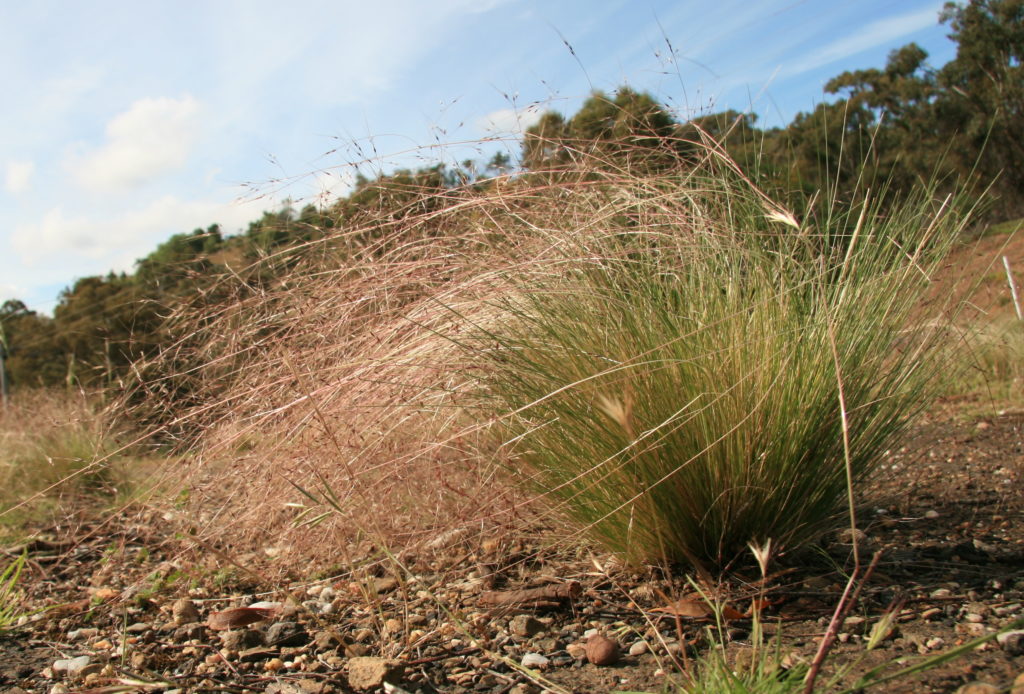
Autumn Woodland Bird Survey
David Nichols
With social isolation restrictions in full force, the autumn round of the Woodland Bird Monitoring was conducted on the 25 of April as a closed event. The monitoring started very promisingly with 18 species recorded in the first 20 minute survey in the Ararat Hills Regional Park. Present were a selection of five species of Honeyeater, including the White-naped Honeyeater, which has not regularly been recorded in our surveys. Also seen here were a Golden Whistler and the Eastern Spinebill.
Next, we headed to the Wills Hill Road site, where things began to quieten down, with 10 species recorded in the 20 minute survey. The usual cross-section of birds recorded at this site did include a Wedge-tailed Eagle and a very ‘showy’ Yellow Thornbill. But no sign of the White -browed Babblers or the Red-capped Robins that have been seen at this site before.
Lastly to Burrumbeet Road and a quieter survey still, with seven species recorded in the survey time. These included the usual selection of magpies, Superb Fairy Wren, Brown Thornbill and Weebill, White -throated Treecreeper, Grey Fantail and White-eared Honeyeater.
With an easing of social isolation restrictions, the next round of woodland bird monitoring surveys in spring is looking like a good opportunity to get out with other group members for a wander around some of favourite birds-on-farms sites.
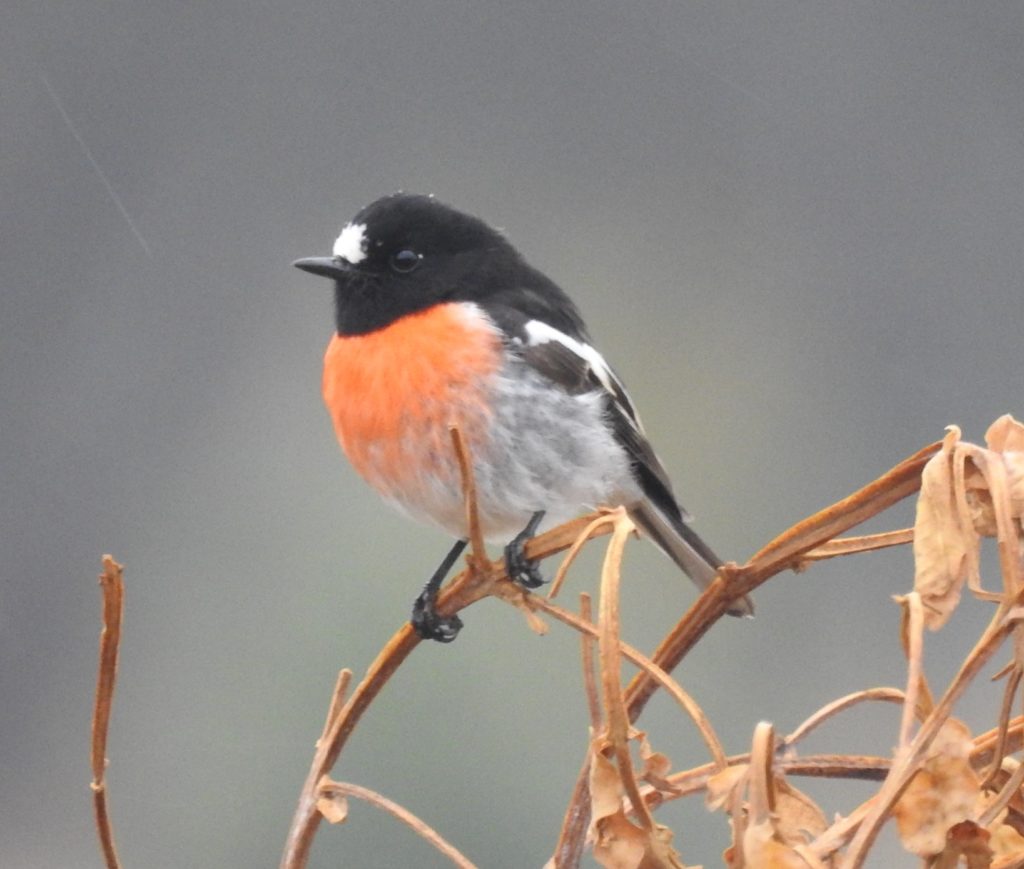
Scarlet Robin (Petroica boodang)in the rain 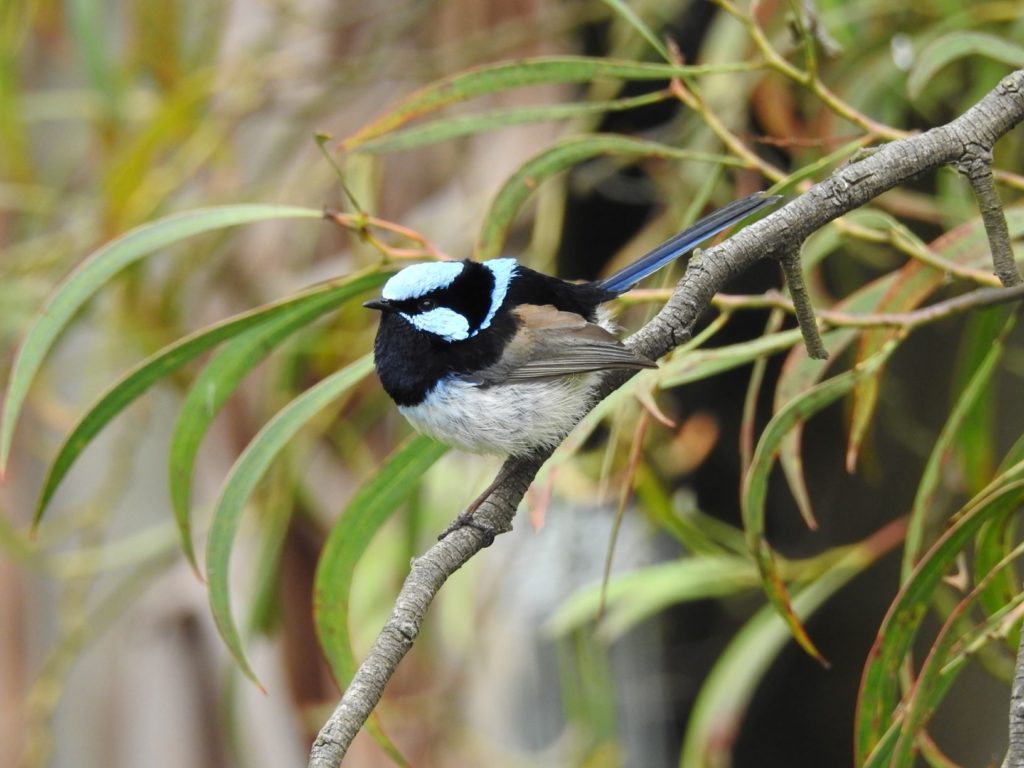
Superb Fairywren (Malurus cyaneus) 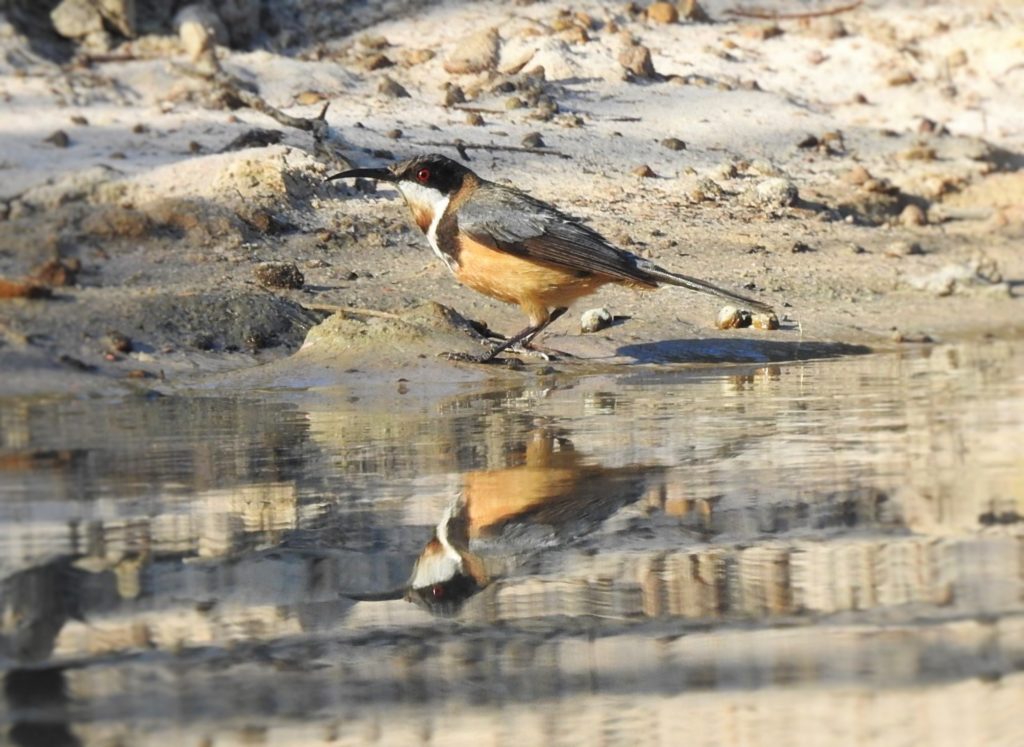
Eastern Spinebill (Acanthorhynchus tenuirostris)
Native grassland restoration at Woorndoo
By John Delpratt, Woorndoo Land Protection Group
In late 2017, the Woorndoo Land Protection Group was awarded a DELWP Biodiversity On-ground Action grant to expand an area of restored grassland at Woorndoo, and to undertake several experiments aimed at enhancing the species diversity of an established native grassland.
An initial 1.25 ha restoration was sown into previously-cropped roadside in 2013. The site extends to the north east from the corner of Bolac Plains Rd. and Woorndoo-Streatham Rd. A thin layer of top soil (approx. 80 to 100 mm) was removed to reduce the soil weed seed and bud bank and the levels of soil nutrients, particularly nitrogen and phosphorus. This is designed to reduce competition from agricultural weeds during the critical establishment phase of the new grassland community. The site was sown with a diverse mix of locally-collected native grassland species, both grasses and herbaceous wild flowers (forbs). The sowing and subsequent establishment of the grassland was very successful and formed the basis for the DELWP-funded project.
The new project had two main objectives.
- To restore a further 1.25 ha adjoining the 2013 site.
- To undertake three experiments over two years aimed at increasing the diversity of forb species and the presence of Kangaroo Grass (Themeda triandra) in the 2013 restoration.
The restoration sowing was scheduled for spring 2019 to allow time for the production and collection of seed resources. The experiments used both sown seed and tube stock planting to refine methods for enhancing the diversity and abundance of forbs within an established native grassland, and to increase the abundance of Kangaroo Grass by tube stock planting. The three fully replicated experiments (forbs from tube stock; forbs from seed; Kangaroo Grass from tube stock) were applied over two years and four seasons (autumn 2018; spring 2018; autumn 2019; spring 2019). Monitoring of establishment, survival and growth is on-going. Broadly, survival and growth of most of the nine planted forb species has been good, the Kangaroo Grass is establishing well but, for a number of possible reasons, only a few of the fifteen direct-sown forbs have established. I will report more fully on these interesting experiments once the establishment period for all seasonal treatments has passed and the data has been analysed. Interestingly, the 2013 site, including the experimental area, was burnt a few weeks ago – a further challenge for the transplants and seedlings. For the rest of this note, I’ll report on the implementation and progress of the 2019 direct sowing.
The 2019 site extends for a further 1.25 ha along the Woorndoo-Streatham Rd. The site replaces part of an area of roadside cropping (wheat and canola) that extends for about 10 km towards Nerrin Nerrin. The final crop on the new site was canola, harvested in 2018. We had budgeted to have the site graded to 100 mm depth in autumn 2019. This coincided with adjacent roadworks for Tilt Renewables’ Dundonnell Wind Farm. The road contractor, Zenviron, agreed to grade the site at no charge to WLPG. This was a substantial saving to our project budget, which allowed us to include a large tube stock planting of Kangaroo Grass and locally-important forbs, in addition to the direct sowing.
Note: Kangaroo Grass is a key species in the region’s natural temperate grasslands. It is always included in our seed mixes but it is relatively slow to mature and to assume its role as a dominant species. Similarly, while a number of forb species, particularly daisies, establish in good abundance from direct-sown seed mixes, other species will take many years to develop large populations. While the primary focus of our restorations is direct sowing because it can be achieved at any scale, for an impatient (and ageing) operator such as myself, it is important to see if it is feasible, on a limited scale, to quickly establish large stands of Kangaroo Grass and rare or culturally-significant forbs such as Button Wrinklewort (Rutidosis leptorhynchoides) and Murnong/Yam Daisy (Microseris walteri), within recently-sown native grassland communities.
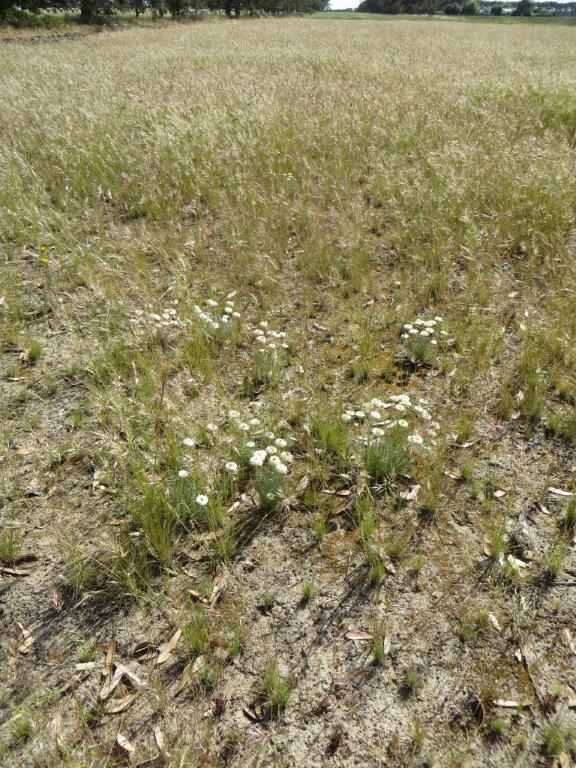
The 2013 site in spring 2014. Already there is a good cover of Wallaby Grass with some forbs (Hoary Sunray; Leucochrysum ablicans ssp. tricolor) in the foreground. In the distance is a wheat crop that has since become the 2019 restoration site. 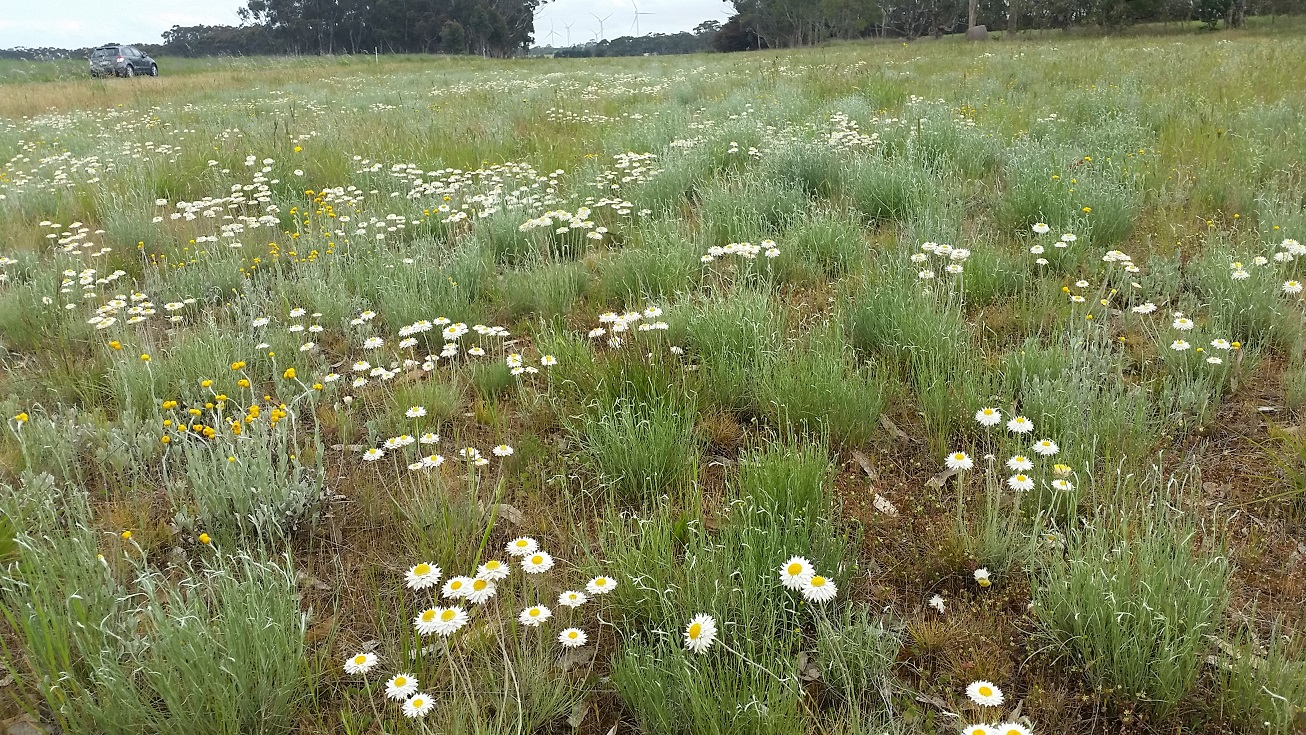
The 2019 Woorndoo restoration site in spring, 2018. The prominent forbs are Hoary Sunray, Common Everlasting (Chrysocephalum apiculatum) and Lemon Beauty-heads (Calocephalus citreus), still to flower. 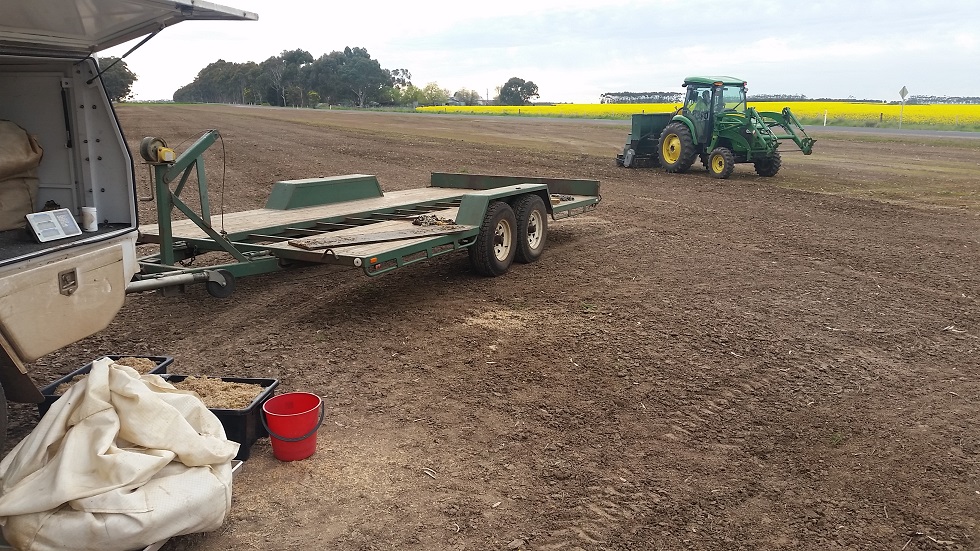
The 2019 site direct sowing operation, October 2019.
The sowing was completed in October 2019. With good follow-up rain over summer and a wetter- than-average autumn, we are seeing excellent growth of native grasses, particularly Wallaby Grass (Rytidosperma species) and various local daisies.
The grading of the site, prior to sowing, was completed in a race against a rapidly approaching autumn break; it was raining as the job was being completed. As a result, the site was not a clean as we would have hoped and there has been more growth of agricultural annual weeds than we would have liked. The most abundant of these weeds is Wire Weed (Polygonum aviculare). While this is disappointing, the good cover of Wallaby Grass should start to suppress this, and other annual weeds over the next few growing seasons – something to watch.
The planned tube stock planting (approx. 6000 plants), which was to have been completed by Landmate, has been delayed by Covid-19. We had planned an autumn and spring planting, in line with our experiments. The stock is ready and in need of planting. We now plan to condense the planting into a single effort in late winter or early spring, depending on the availability of a planting crew. Any later than early spring risks a rapid drying of the soil profile and a failure of the tube stock to establish before summer – potentially leading to large losses.
The Group’s 2013 restoration was an outstanding success – a tribute to a strong community effort and a successful collaboration with Moyne Shire Council. The more recent sowing has doubled the area of restored native grassland and allowed us to learn more about establishing additional species within an established native grassland.
As part of the DELWP project, the Woorndoo Land Protection Group has held increasingly well-attended annual seminar/field days in late spring. In view of the uncertainty surrounding Covid-19, this may not be advisable this year. However, we certainly will be holding an occasion at Woorndoo to report on the completion of the DELWP project as soon as it is safe to do so.
If you would like to follow our progress or become a volunteer, we have a ‘visible’ Facebook page (Woorndoo Land Protection Group) and an email list. To be added to our email list, please email woorndoolandprotectiongroup@gmail.com.
Update on the Stavely Ground Release
The Department of Jobs, Precincts and Regions (DJPR) will host three community information sessions in June for local agricultural landholders to help you learn more about minerals exploration and your rights, environmental safeguards and the obligations of minerals exploration companies. The sessions are relevant for landholders in the areas around Glenthompson, Caramut, Chatsworth, Minjah and west of Mortlake.
Due to current coronavirus restrictions on social gatherings, these sessions will be held online:
Wednesday 10 June – 12.30pm-2pm
Wednesday 10 June – 3.30pm-5pm
Thursday 11 June – 7pm-8.30pm
You can register for a session via the department’s website.
Each 90-minute session will include presentations from representatives of the Department of Jobs, Precincts and Regions and Westrock Minerals. There will be opportunity to ask questions. During these sessions they will present the range of support available to assist landholders in any discussions with minerals explorers about potential access to your property.
If you need further information or believe that you might have difficulty accessing online sessions but would still like to be involved, please contact Donna Mongan on 0436 662 399.

Meanderings and reflections
I headed out to do water quality monitoring at the end of May, after the rain. It was a pleasant reprieve from school-at-home, and it was good to get out and have a look around the district again. It had rained for a few days before the surveys so some of the sites had a new flush of water and others were running a bit higher than I had seen in a while.
The Upper Hopkins LMG has nearly twenty years of EC data that has been collected quarterly throughout the district. This is a great resource! I am investigating new ways to share this data with you in our newsletter so it might look a little bit different this time. As part of the Waterway Twinning project, I’m also figuring out how I can share the data with others so that it can be incorporated into large databases and be useful for understanding long-term trends.
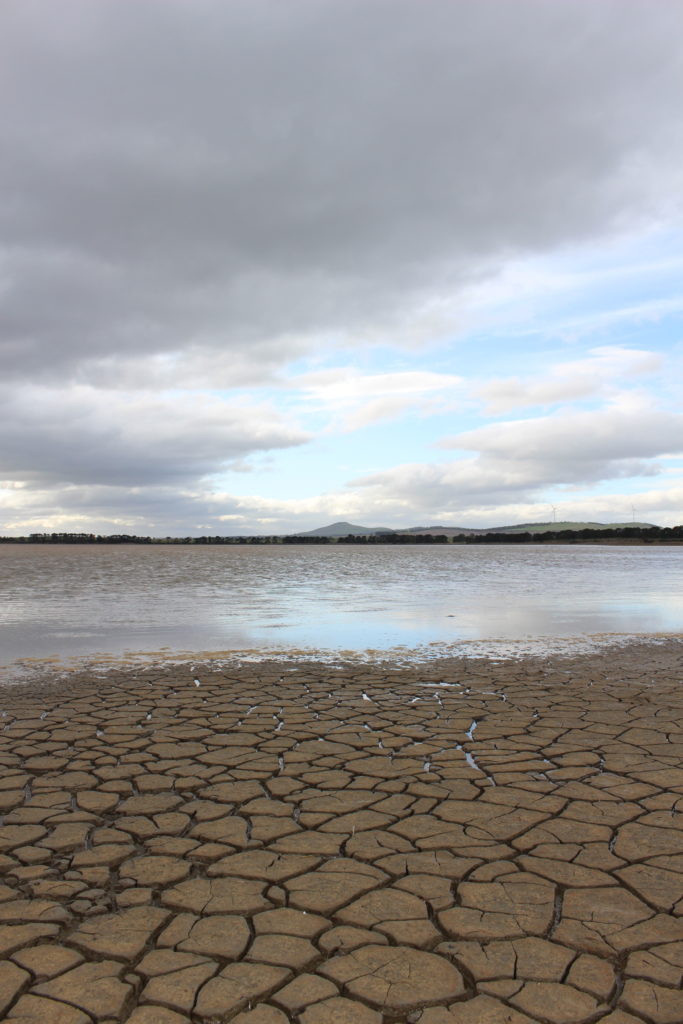
Lake Buninjon is starting to fill 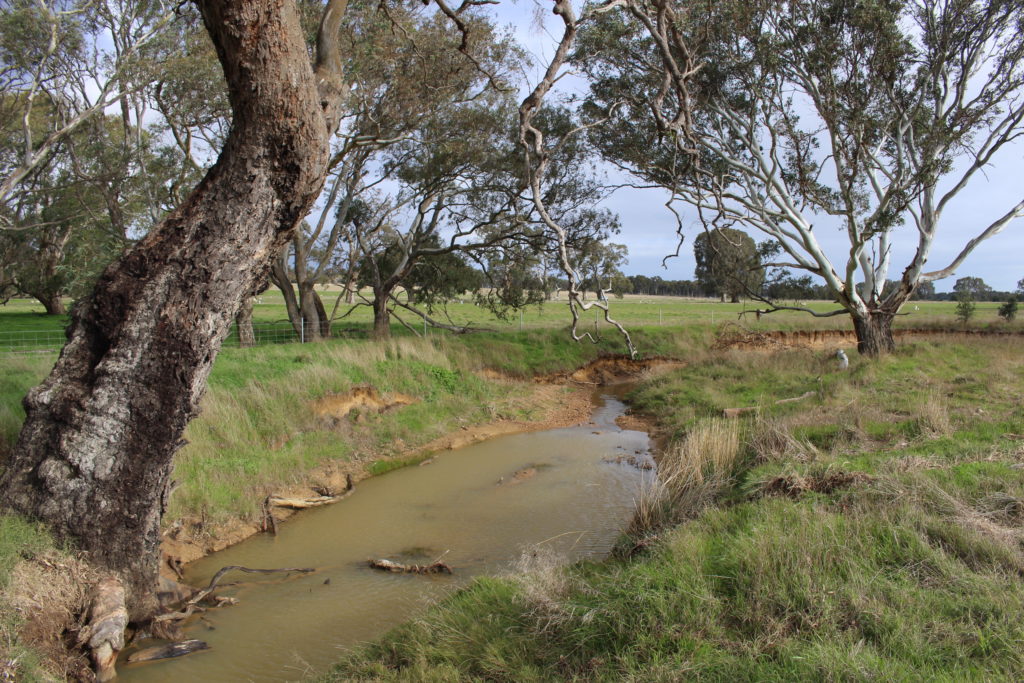
Some small creeks were quite turbid after recent rain 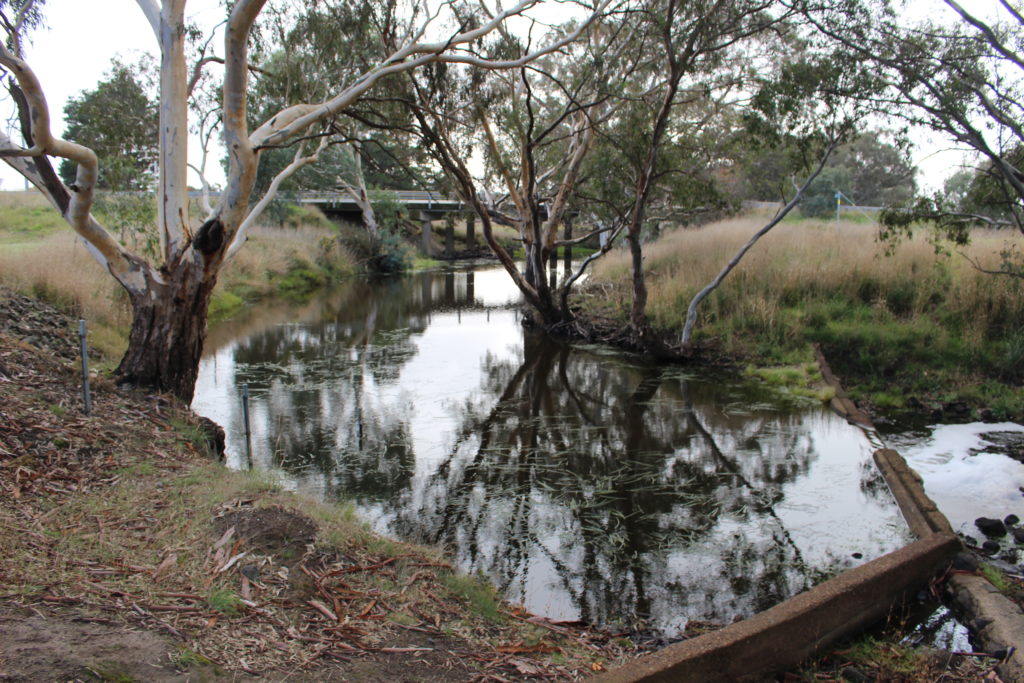
The Fiery Creek is flowing at Streatham
Water results
You can view the EC data in the table below, or click on the link to download a file. Data from Upper Mt Emu Creek will be added soon.
EC levels for livestock water supplies. Value given in brackets for each type of livestock is the EC level at which production decline begins: Beef cattle (6,200 EC μS/cm), lactating ewes and weaners (6,000 EC μS/cm), dry sheep (9,300 EC μS/cm)), horses (6,200 EC μS/cm), Pigs (3,100 EC μS/cm), poultry 3,100 EC μS/cm).
| site | winter 2020 | autumn 2020 | average | minimum | maximum |
| Fiery Creek – Fishermans Pontoon | 9900 | 11190 | 10499.3 | 1410 | 53000 |
| Lake Bolac – South Beach Boat Ramp | 9880 | 11120 | 14904.3 | 3840 | 55600 |
| Lake Bolac – East Beach boat ramp | 9720 | 11100 | 10919.8 | 3450 | 51600 |
| Charleycombe Creek – Old Geelong Road | dry | dry | 1691.2 | 250 | 9200 |
| Fiery Creek – Ballyrogan Road | 8420 | 7540 | 3603.9 | 380 | 10500 |
| Billy Billy creek – Buangor township | 168 | 438 | 957.9 | 168 | 8060 |
| Middle Creek – Willow tree Road | 323 | dry | 445.1 | 100 | 3700 |
| Fiery Creek – Lucardies Road | 2490 | dry | 1110.0 | 170 | 9850 |
| Tatyoon drainage line – Rockies Hill Road | 11230 | 23500 | 14592.1 | 360 | 28200 |
| Challicum Creek – Porters Bridge Road | 11600 | 15240 | 11177.1 | 145 | 26680 |
| Fiery Creek – Porters Bridge Road | 7230 | 10230 | 5453.9 | 550 | 11930 |
| Fiery Creek – Mt William Road | 2600 | 3300 | 2355.2 | 500 | 5950 |
| Wongan Creek – Mt William Road | 11780 | 12380 | 9912.6 | 1060 | 15590 |
| Wongan Creek – Coburns Lane | 11730 | 8020 | 9125.0 | 3400 | 14000 |
| Fiery Creek – Yalla-Y- Poora Road | 6980 | 10720 | 4879.9 | 550 | 10930 |
| Fiery Creek – Gordon Bridge | 5970 | 7790 | 4983.7 | 530 | 17560 |
| Fiery Creek – Runway Swamp Road | 11400 | 6780 | 5175.6 | 860 | 14520 |
| Fiery Creek – Ritchies Road Bridge | 11700 | 7300 | 5363.3 | 860 | 14350 |
| Fiery Creek – Streatham Reserve | 7990 | 6770 | 4490.5 | 770 | 11600 |
| Fiery Creek – McCrows Road/Nerrin Nerrin Estate Road | 12300 | 12210 | 7635.9 | 780 | 13770 |
| Fiery Creek – Lake Bolac | 10040 | 11450 | 7991.1 | 850 | 22280 |
| Lake Buninjon | 18820 | dry | 16139.8 | 880 | 104000 |
| Good Morning Bill Creek and Nekeeya Creek combined – Buninjon West Road | 10140 | 33720 | 11502.1 | 300 | 39000 |
| Good Morning Bill Creek and Nekeeya Creek combined – Moyston-Willaura Road | 11300 | 13060 | 8792.8 | 300 | 15500 |
| Good Morning Bill Creek (Mt Moornambel arm) – Taits Lane | 480 | dry | 1840.4 | 330 | 6500 |
| Good Morning Bill Creek (west arm) – Taits Lane | 121 | 234 | 1199.5 | 100 | 10710 |
| Nekeeya Creek – Sandhills Road | 156 | dry | 674.7 | 100 | 8620 |
| Good Morning Bill Creek – Burrumbeep Road | 7080 | 27380 | 10359.3 | 480 | 27380 |
| Hopkins River – Bridge on Labrador Road | 4360 | 10270 | 6051.9 | 337 | 11200 |
| Hopkins River – Helendoite Road | 4690 | 10870 | 5808.7 | 299 | 10870 |
| Jacksons Creek – Coopers Road | 10460 | puddle only | 8577.6 | 244 | 15900 |
| Hopkins River – Robertsons Bridge (Langi Logan Road) | 3340 | 8420 | 4759.7 | 327 | 13000 |
| Creek from Rocky Point – Ararat-Warrnambool Road | dry | dry | 3809.1 | 180 | 9600 |
| Denicull Creek – Denicull Creek Road | 3070 | dry | 7022.1 | 890 | 10900 |
| Hopkins River – Tatyoon Road (south of Kangaroo Point Road) | 326 | dry | 4566.4 | 326 | 13800 |
| Hopkins River – Burrumbeep Boundary Road | 1440 | 7480 | 5313.6 | 330 | 11700 |
| Hopkins River – Jacksons Creek Road | 4980 | 10690 | 6271.7 | 340 | 12100 |
| Hopkins River – Warrak Road (Hopkins River Road) | 8300 | 12450 | 9035.8 | 490 | 23280 |
| Three Mile Creek – Warrayatkin Road – South of Warrak Road | 9750 | dry | 7900.9 | 600 | 22400 |
| Three Mile Creek – Warrak Road – west of Warrayatkin Road | 10030 | dry | 2676.8 | 390 | 13600 |
| Cemetery Creek – Warrak Road (Ararat) | 6790 | dry | 1114.4 | 130 | 9620 |
| Green Hill Lake (south end) – Height Gauge rec reserve | 3280 | 3680 | 6201.3 | 340 | 28800 |
| Hopkins River – Old Geelong Road | 3200 | 15210 | 8374.2 | 500 | 16300 |
| Hopkins River – Dobie Road | 4010 | 6350 | 5760.9 | 160 | 15900 |
| Gorrin Creek – Dobie Road | 370 | 1148 | 687.1 | 100 | 5100 |
| Captains Creek – Tatyoon North Road | 479 | 530 | 497.3 | 100 | 3500 |
| Hopkins River – Wickliffe – Glenelg Highway | 12140 | 18060 | 10672.1 | 1590 | 19000 |
| Hopkins River – Major Mitchell Road bridge | 11570 | 17830 | 10849.4 | 1650 | 23240 |
| Hopkins River – Back Bolac Road | 11460 | 18650 | 1178.0 | 1620 | 29600 |
| Hopkins River – Willaura Golf Links Road | 11640 | 18400 | 10030.9 | 1600 | 18400 |
| Hopkins River – Bald Hill Road foRoad | 10770 | 15660 | 10765.9 | 1980 | 31800 |
| Hopkins River – Delacombe Way (Edgarley Bridge) | 9880 | 13720 | 9702.3 | 1790 | 17400 |
| Hopkins River – Rossbridge | 8010 | 14240 | 3250.9 | 820 | 14240 |
| Rossbridge Swamp drainage line – Grange Road | 236 | dry | 17190.9 | 236 | 36800 |
| Trawalla Creek – Bridge, Waterloo | 1910 | 2980 | 3440.1 | 340 | 16100 |
| Trawalla Creek – Back Waterloo Road, bridge | 3100 | 2460 | 2664.4 | 400 | 15300 |
| Trawalla Creek – Racecourse Road near Jones Road | 5600 | 2970 | 2982.0 | 410 | 9330 |
| Mt Emu Creek – Trawalla bridge | 1440 | 1200 | 1928.4 | 440 | 6400 |
| Spring Hill Creek – Trawalla East Road | 3800 | 5640 | 4697.9 | 300 | 8300 |
| Spring Hill Creek – Trawalla-Carngham Road bridge | 4100 | 5450 | 4791.7 | 320 | 8300 |
| Spring Hill Creek – Trawalla Road | 4500 | 7650 | 5968.5 | 360 | 11500 |
| Baillie Creek – Beaufort Carngham Road | 5500 | 6740 | 5476.7 | 840 | 10320 |
| Mt Emu Creek – Beaufort Carngham Road – twin bridge W | 4400 | 2040 | 2128.0 | 420 | 4400 |
| Mt Emu Creek – Beaufort Carngham Road – twin bridge E | 4200 | 8850 | 5203.3 | 360 | 8850 |
| Mt Emu Creek – Lake Goldsmith Road | 4200 | 3350 | 3248.8 | 370 | 6400 |
| Mt Emu Creek – Streatham-Carngham Road | 5100 | 3110 | 2868.5 | 130 | 12200 |
| Baillie Creek – Streatham Mortchup Road | 4800 | 4860 | 5125.9 | 660 | 12200 |
| Mt Emu Creek – Mt Emu Settlement Road | 4200 | 3240 | 4978.9 | 390 | 11490 |
| Mt Emu Creek – Skipton | 4500 | 3160 | 4496.4 | 440 | 8240 |
| Broken Creek – Millers Road | 7400 | 8650 | 8025.0 | 7400 | 8650 |
| Broken Creek – Glenelg Highway | 7400 | 5520 | 6460.0 | 5520 | 7400 |
Keep in touch
| Upper Hopkins Land Management Group | Ayesha Burdett | Landcare Facilitator | 0429 021 500 |
| Jack Tucker | President | 0427 547 636 | |
| Celia Tucker | Secretary | 0409 138 581 | |
| Kelly Gellie | Treasurer | 0439 722 985 | |
| Glenelg Hopkins Catchment Management Authority | Waterways, Wetlands, Works on Waterways Permits | 03 5571 2526 | |
| Ararat Rural City Council | Deirdre Andrews | Waste and Sustainability Coordinator | 03 5355 0233 |
| Agriculture Victoria | Clem Sturmfels | Soil conservation, incentives and whole farm planning | 03 5355 0535 |
| Perennial Pasture Systems | Rob Shea | Facilitator, Perennial Pasture Systems | 0438 521 357 |
| Debbie Shea | Facilitator, Girls & Grass Advisory Group | 0418 205 353 | |
| Trust for Nature | Adam Merrick | Conservation agreements, grants, biodiversity technical advice | 0458 965 333 |
| Beyond Bolac Catchment Action Group | Anthony Casanova | Landcare Facilitator | 0409 506 533 |
Disclaimer: This publication may be of assistance to you but the Upper Hopkins Land Management Group does not guarantee that the publication is without flaw of any kind or is wholly appropriate for your particular purposes and therefore disclaims all liability for any error, loss or other consequence which may arise from you relying on any information in this publication.

